2.1: Introducing Financial Statements
2.1.1: Defining the Financial Statement
Financial statements report on a company’s income, cash flow and equity.
Learning Objective
Define the purpose of a financial statement
Key Points
- Financial statements are formally prepared documents communicating an entity’s financial activities to parties including investors, management and tax officials.
- An entity’s financial statement typically includes four basic components: a balance sheet, income statement, cash flow statement, and statement of changes in equity.
- The balance sheet reports a point-in-time snapshot of the assets, liabilities and equity of the entity.
- An income statement reports on a company’s expenses and profits to show whether the company made or lost money.
- The cash flow statement reports the flow of cash in and out of the business, dividing cash into operating, investing and financing activities.
- A statement of changes in equity explains the changes of the company’s equity throughout the reporting period, including profits or losses, dividends paid and issue or redemption of stock.
Key Terms
- liabilities
-
an obligation of an entity arising from past transactions or events, including any type of borrowing
- equity
-
The residual claim or interest to investors in assets after all liabilities are paid. If liability exceeds assets, negative equity exists and can be purchased through stock.
- Assets
-
economic resources that represent value of ownership that can be converted into cash (although cash itself is also considered an asset)
A financial statement is a formal report of the financial activities of a business, person, or other entity. Financial statements are a key component of accounting; the process of communicating information about a financial entity . Financial statements are presented in a structured manner with conventions accepted by accounting and regulatory personnel. An entity’s financial statement typically includes four basic components: a balance sheet, income statement, cash flow statement, and statement of changes in equity:

Keeping Money Organized
Financial Statements help keep money organized.
- The company’s balance sheet reports on a company’s assets, liabilities and ownership equity. A balance sheet is often described as a “snapshot of a company’s financial condition” at a single point in time. Balance sheets are usually presented with assets in one section and liabilities and net worth in the other.
- An income statement reports on a company’s expenses and profits to show whether the company made or lost money. It also displays the revenues of a specific period, and the cost and expenses charged against these revenues. In contrast with the balance sheet, which represents a single moment in time, the income statement represents a period of time
- A cash flow statement shows how changes in income affect cash and cash equivalents, breaking the analysis down to operating, investing and financing. Essentially, the cash flow statement is concerned with the flow of cash in and out of the business. As an analytical tool, a cash flow statement is useful in determining the short-term viability of a company.
- A statement of changes in equity explains the company’s equity throughout the reporting period. The statement breaks down changes in the owners’ interest in the organization and in the application of retained profit or surplus from one accounting period to the next. Line items typically include profits or losses, dividends paid, redemption of stock, and any other items credited to retained earnings.
For complex entities, financial statements often include an extensive set of notes as an explanation of financial policies. The notes typically describe each item in detail. For example, the notes may explain financial figures or the accounting methods used to prepare the statement.
2.1.2: Uses of the Financial Statement
Financial statements are used to understand key facts about the performance and disposition of a business and may influence decisions.
Learning Objective
Explain how financial statements are used by different entities
Key Points
- Owners and managers use financial statements to make important long-term business decisions. For example: whether or not to continue or discontinue part of its business, to make or purchase certain materials, or to acquire or rent/lease certain equipment in the production of its goods.
- Prospective investors use financial statements to perform financial analysis, which is a key component in making investment decisions.
- A lending institution will examine the financial health of a person or organization and use the financial statement to decide whether or not to lend funds.
Key Term
- financial analysis
-
Financial analysis (also referred to as financial statement analysis) refers to an assessment of the viability, stability, and profitability of an organization or project.
Uses of a Financial Statement
Financial Statements are used for a Multitude of Different Purposes
Readers of a financial statement are seeking to understand key facts about the performance and disposition of a business. They make decisions about the business based on their reading of the statements. Because financial statements are widely relied upon, they must be straightforward to read and understand.
For large corporations, these statements are often complex and may include an extensive set of notes to the financial statements and explanation of financial policies andmanagement discussion and analysis. The notes typically describe each item on the balance sheet, income statement, and cash flow statement in further detail. Notes to financial statements are considered an integral part of the financial statements.
Owners and managers frequently use financial statements to make important business decisions, for example:
- Whether or not to continue or discontinue part of the business.
- Whether to make or to purchase certain materials.
- Whether to acquire or to rent/lease certain equipment in the production of goods.
The documents are also helpful in making long-term decisions and as a source of historical records .
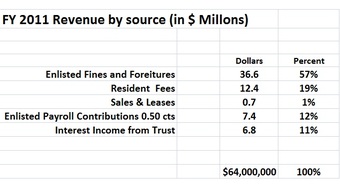
Budget
One of the uses of financial statements is as a budgeting tool, as in this example.
Other individuals and entities use financial statements too. For example:
- Prospective investors use financial statements to perform financial analysis, which is a key component in making investment decisions.
- A lending institution will examine the financial health of a person or organization and use the financial statement to decide whether or not to lend funds.
- Philanthropies may use financial statements of a non-profit as a component in determining where to donate funds.
- Government entities (tax authorities) need financial statements to ascertain the propriety and accuracy of taxes and other duties declared and paid by a company.
- Vendors who extend credit may use financial statements to assess the creditworthiness of the business.
- Employees also may use reports in making collective bargaining agreements
2.1.3: Limitations of Financial Statements
Financial statements can be limited by intentional manipulation, differences in accounting methods, and a sole focus on economic measures.
Learning Objective
Summarize the common limitations found in financial statements
Key Points
- One limitation of financial statements is that they are open to human interpretation and error, in some cases even intentional manipulation of figures to inflate economic performance.
- Another set of limitations of financial statements arises from different ways of accounting for activities across time periods and across companies, which can make comparisons difficult.
- Another limit to financial statements as a window into the creditworthiness or investment attractiveness of an entity is that financial statements focus solely on financial measures. Some argue for a “triple bottom line” including social and environmental measures.
Key Terms
- GAAP
-
An acronym for “Generally Accepted Accounting Principles.“ The standard framework of guidelines for financial accounting used in any given jurisdiction; generally known as accounting standards or standard accounting practice.
- audit
-
The verification of the financial statements of a legal entity intended to enhance the degree of confidence of intended users in the financial statements by providing reasonable assurance that the financial statements are presented fairly.
- corporate governance
-
The roles and relationships between a company’s management, its board, its shareholders and other stakeholders, and the goals for which the corporation is governed. Much of the contemporary interest in corporate governance is concerned with mitigation of the conflicts of interests and the nature and extent of accountability of people in the business.
Limitations of Financial Statements
The limitations of financial statements include inaccuracies due to intentional manipulation of figures; cross-time or cross-company comparison difficulties if statements are prepared with different accounting methods; and an incomplete record of a firm’s economic prospects, some argue, due to a sole focus on financial measures.
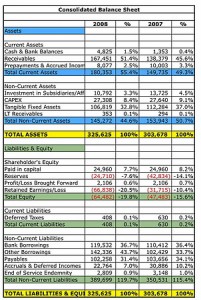
Consolidated financial statements
Financial statements can include a number of inaccuracies and limitations that affect the way a company can be viewed.
One limitation of financial statements is that they are open to human interpretation and error, in some cases even intentional manipulation of figures. In the United States, especially in the post-Enron era, there has been substantial concern about the accuracy of financial statements. High-profile cases in which management manipulated figures in financial statements to indicate inflated economic performance highlighted the need to review the effectiveness of accounting standards, auditing regulations, and corporate governance principles.
As a result, there has been renewed focus on the objectivity and independence of auditing firms. An audit of the financial statements of a public company is usually required for investment, financing, and tax purposes, and these are usually performed by independent accountants or auditing firms and included in the annual report. Additionally, in terms of corporate governance, managing officials like the CEO and CFO are personally liable for attesting that financial statements are not untrue or misleading, and making or certifying misleading financial statements exposes the people involved to substantial civil and criminal liability.
Another set of limitations of financial statements arises from different ways of accounting for activities across time periods and across companies. This can make it difficult to compare a company’s finances across time or to compare finances across companies. Different countries have developed their own accounting principles, making international comparisons of companies difficult. However, the Generally Accepted Accounting Principles (GAAP), a set of guidelines and rules, are one means by which uniformity and comparability between financial statements is improved. Recently there has been a push toward standardizing accounting rules made by the International Accounting Standards Board (IASB).
Another limit to financial statements as a window into the creditworthiness or investment attractiveness of an entity is that financial statements focus solely on financial measures of health. Even traditional investment analysis incorporates information outside of the financial statements to make organizational assessments. However, other methods such as full cost accounting (FCA) or true cost accounting (TCA) argue that an organization’s health cannot just be determined by its economic characteristics. Therefore, one needs to collect and present information about environmental, social, and economic costs and benefits (collectively known as the “triple bottom line”) to make an accurate evaluation.
2.2: The Income Statement
2.2.1: Elements of the Income Statement
The income statement, or profit and loss statement (P&L), reports a company’s revenue, expenses, and net income over a period of time.
Learning Objective
Construct a complete income statement
Key Points
- The income statement consists of revenues and expenses along with the resulting net income or loss over a period of time due to earning activities. The income statement shows investors and management if the firm made money during the period reported.
- The operating section of an income statement includes revenue and expenses. Revenue consists of cash inflows or other enhancements of assets of an entity, and expenses consist of cash outflows or other using-up of assets or incurring of liabilities.
- The non-operating section includes revenues and gains from non-primary business activities, items that are either unusual or infrequent, finance costs like interest expense, and income tax expense.
- The “bottom line” of an income statement is the net income that is calculated after subtracting the expenses from revenue. It is important to investors – also on a per share basis (as earnings per share, EPS) – as it represents the profit for the accounting period attributable to the shareholders.
Key Terms
- net income
-
Gross profit minus operating expenses and taxes.
- gross profit
-
The difference between net sales and the cost of goods sold.
- income statement
-
a calculation which shows the profit or loss of an accounting unit during a specific period of time, providing a summary of how the profit or loss is calculated from gross revenue and expenses
- income bond
-
a debt instrument where coupon payments are only made if the issuer can afford it
- statement of cash flows
-
a financial document that shows how changes in balance sheet accounts and income affect cash and cash equivalents, and breaks the analysis down to operating, investing, and financing activities
Elements of the Income Statement
The income statement is a financial statement that is used to help determine the past financial performance of the enterprise, predict future performance, and assess the capability of generating future cash flows . It is also known as the profit and loss statement (P&L), statement of operations, or statement of earnings.
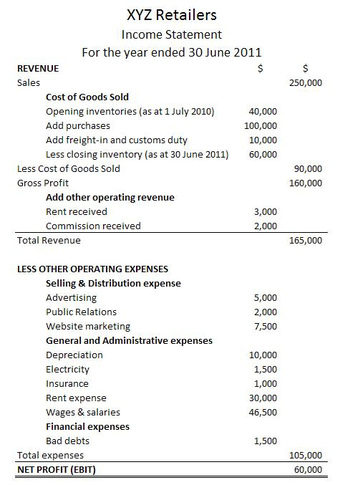
A Sample Income Statement
Expenses are listed on a company’s income statement.
The income statement consists of revenues (money received from the sale of products and services, before expenses are taken out, also known as the “top line”) and expenses, along with the resulting net income or loss over a period of time due to earning activities. Net income (the “bottom line”) is the result after all revenues and expenses have been accounted for. The income statement reflects a company’s performance over a period of time. This is in contrast to the balance sheet, which represents a single moment in time.
Methods for Constructing the Income Statement
The income statement can be prepared in one of two methods: single or multi-step.
The Single Step income statement totals revenues, then subtracts all expenses to find the bottom line.
The more complex Multi-Step income statement (as the name implies) takes several steps to find the bottom line. First, operating expenses are subtracted from gross profit. This yields income from operations. Then other revenues are added and other expenses are subtracted. This yields income before taxes. The final step is to deduct taxes, which finally produces the net income for the period measured.
Operating Revenues and Expenses
The operating section includes revenue and expenses. Revenue consists of cash inflows or other enhancements of the assets of an entity. It is often referred to as gross revenue or sales revenue. Expenses consist of cash outflows or other using-up of assets or incurrence of liabilities.
Elements of expenses include:
- Cost of Goods Sold (COGS): the direct costs attributable to goods produced and sold by a business. It includes items such as material costs and direct labor.
- Selling, General and Administrative Expenses (SG&A): combined payroll costs, except for what has been included as direct labor.
- Depreciation and amortization: charges with respect to fixed assets (depreciation) and intangible assets (amortization) that have been capitalized on the balance sheet for a specific accounting period.
- Research & Development (R&D): expenses included in research and development of products.
Non-operating Revenues and Expenses
The non-operating section includes revenues and gains from non- primary business activities (such as rent or patent income); expenses or losses not related to primary business operations (such as foreign exchange losses); gains that are either unusual or infrequent, but not both; finance costs (costs of borrowing, such as interest expense); and income tax expense.
In essence, if an activity is not a part of making or selling the products or services, but still affects the income of the business, it is a non-operating revenue or expense.
Reading the Income Statement
Certain items must be disclosed separately in the notes if it is material (significant). This could include items such as restructurings, discontinued operations, and disposals of investments or of property, plant and equipment. Irregular items are reported separately so that users can better predict future cash flows.
The “bottom line” of an income statement—often, literally the last line of the statement—is the net income that is calculated after subtracting the expenses from revenue. It is important to investors as it represents the profit for the year attributable to the shareholders. For companies with shareholders, earnings per share (EPS) are also an important metric and are required to be disclosed on the income statement.
2.2.2: Limitations of the Income Statement
Income statements have several limitations stemming from estimation difficulties, reporting error, and fraud.
Learning Objective
Demonstrate how the limitations of the income statement can influence valuation
Key Points
- Income statements include judgments and estimates, which mean that items that might be relevant but cannot be reliably measured are not reported and that some reported figures have a subjective component.
- With respect to accounting methods, one of the limitations of the income statement is that income is reported based on accounting rules and often does not reflect cash changing hands.
- Income statements can also be limited by fraud, such as earnings management, which occurs when managers use judgment in financial reporting to intentionally alter financial reports to show an artificial increase (or decrease) of revenues, profits, or earnings per share figures.
Key Terms
- LIFO
-
Method for accounting for inventory. LIFO stands for last-in, first-out, and assumes that the most recently produced items are recorded as sold first.
- FIFO
-
Method for for accounting for inventories. FIFO stands for first-in, first-out, and assumes that the oldest inventory items are recorded as sold first.
- matching principle
-
According to the principle, expenses are recognized when obligations are (1) incurred (usually when goods are transferred or services rendered, e.g. sold), and (2) offset against recognized revenues, which were generated from those expenses, no matter when cash is paid out. In cash accounting—in contrast—expenses are recognized when cash is paid out.
Income statements are a key component to valuation but have several limitations: items that might be relevant but cannot be reliably measured are not reported (such as brand loyalty); some figures depend on accounting methods used (for example, use of FIFO or LIFO accounting); and some numbers depend on judgments and estimates. In addition to these limitations, there are limitations stemming from the intentional manipulation of finances.
One of the limitations of the income statement is that income is reported based on accounting rules and often does not reflect cash changing hands. This could be due to the matching principle, which is the accounting principle that requires expenses to be matched to revenues and reported at the same time. Expenses incurred to produce a product are not reported in the income statement until that product is sold. Another common difference across income statements is the method used to calculate inventory, either FIFO or LIFO.
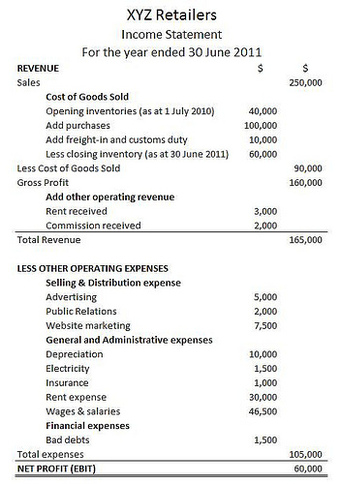
Income statement
Accounting for inventory can be done in different ways, leading to differences in statements.
In addition to good faith differences in interpretations and reporting of financial data in income statements, these financial statements can be limited by intentional misrepresentation. One example of this is earnings management, which occurs when managers use judgment in financial reporting and in structuring transactions to alter financial reports in a way that usually involves the artificial increase (or decrease) of revenues, profits, or earnings per share figures.
The goal with earnings management is to influence views about the finances of the firm. Aggressive earnings management is a form of fraud and differs from reporting error. Managers could seek to manage earnings for a number of reasons. For example, if a manager earns his or her bonus based on revenue levels at the end of December, there is an incentive to try to represent more revenues in December so as to increase the size of the bonus.
While it is relatively easy for an auditor to detect error, part of the difficulty in determining whether an error was intentional or accidental lies in the accepted recognition that calculations are estimates. It is therefore possible for legitimate business practices to develop into unacceptable financial reporting.
2.2.3: Effects of GAAP on the Income Statement
GAAP’s assumptions, principles, and constraints can affect income statements through temporary (timing) and permanent differences.
Learning Objective
Apply the four basic GAAP principles when preparing financial statements
Key Points
- Items that create temporary differences due to the recording requirements of GAAP include rent or other revenue collected in advance, estimated expenses, and deferred tax liabilities and assets.
- Also there are events, usually one-time events, which create “permanent differences,” such as GAAP recognizing as an expense an item that the IRS will not allow to be deducted.
- The four basic principles of GAAP can affect items on the income statement. These principles include the historical cost principle, revenue recognition principle, matching principle, and full disclosure principle.
Key Terms
- fair market value
-
An estimate of the market value of a property, based on what a knowledgeable, willing, and unpressured buyer would probably pay to a knowledgeable, willing, and unpressured seller in the market. An estimate of fair market value may be founded either on precedent or extrapolation but is subjective. Fair market value differs from other ways of determining value, such as intrinsic and imposed value.
- deferred
-
Of or pertaining to a value that is not realized until a future date, e.g. annuities, charges, taxes, income, either as an asset or liability.
Although most of the information on a company’s income tax return comes from the income statement, there often is a difference between pretax income and taxable income. These differences are due to the recording requirements of GAAP for financial accounting (usually following the matching principle and allowing for accruals of revenue and expenses) and the requirements of the IRS’s tax regulations for tax accounting (which are more oriented to cash).
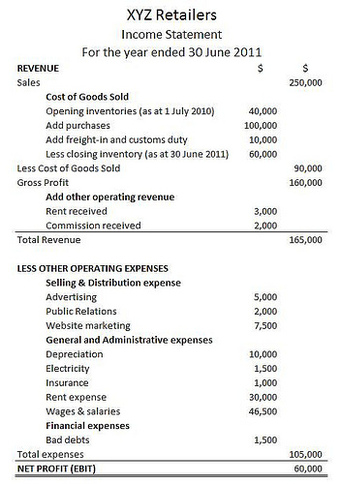
Income statement
GAAP and IRS accounting can differ.
Such timing differences between financial accounting and tax accounting create temporary differences. For example, rent or other revenue collected in advance, estimated expenses, and deferred tax liabilities and assets may create timing differences. Also, there are events, usually one time, which create “permanent differences,” such as GAAP, which recognizes as an expense an item that the IRS will not allow to be deducted.
To achieve basic objectives and implement fundamental qualities, GAAP has four basic principles:
- The historical cost principle: It requires companies to account and report based on acquisition costs rather than fair market value for most assets and liabilities.
- The revenue recognition principle. It requires companies to record when revenue is (1) realized or realizable and (2) earned, not when cash is received.
- The matching principle. This governs the matching of expenses and revenues, where expenses are recognized, not when the work is performed or when a product is produced, but when the work or the product actually makes its contribution to revenue.
- The full disclosure principle. This suggests that the amount and kinds of information disclosed should be decided based on a trade-off analysis, since a larger amount of information costs more to prepare and use. GAAP reporting also suggests that income statements should present financial figures that are objective, material, consistent, and conservative.
2.2.4: Noncash Items
Noncash items, such as depreciation and amortization, will affect differences between the income statement and cash flow statement.
Learning Objective
Identify noncash items that can affect the income statement
Key Points
- Noncash items should be added back in when analyzing income statements to determine cash flow because they do not contribute to the inflow or outflow of cash like other gains and expenses eventually do.
- Depreciation refers to the decrease in value of assets and the allocation of the cost of assets to periods in which the assets are used–for tangible assets, such as machinery.
- Amortization is a similar process to deprecation when applied to intangible assets, such as patents and trademarks.
Key Terms
- obsolescence
-
The state of being obsolete—no longer in use; gone into disuse; disused or neglected.
- amortization
-
The distribution of the cost of an intangible asset, such as an intellectual property right, over the projected useful life of the asset.
- depreciation
-
The measurement of the decline in value of assets. Not to be confused with impairment, which is the measurement of the unplanned, extraordinary decline in value of assets.
Noncash Items
Noncash items that are reported on an income statement will cause differences between the income statement and cash flow statement. Common noncash items are related to the investing and financing of assets and liabilities, and depreciation and amortization. When analyzing income statements to determine the true cash flow of a business, these items should be added back in because they do not contribute to inflow or outflow of cash like other gains and expenses.
Fixed assets, also known as a non-current asset or as property, plant, and equipment (PP&E), is an accounting term for assets and property. Unlike current assets such as cash accounts receivable, PP&E are not very liquid. PP&E are often considered fixed assets: they are expected to have relatively long life, and are not easily changed into another asset . These often receive a more favorable tax treatment than short-term assets in the form of depreciation allowances.

Machinery
Machinery is an example of a noncash asset.
Broadly speaking, depreciation is a way of accounting for the decreasing value of long-term assets over time. A machine bought in 2012, for example, will not be worth the same amount in 2022 because of things like wear-and-tear and obsolescence.
On a more detailed level, depreciation refers to two very different but related concepts: the decrease in the value of tangible assets (fair value depreciation) and the allocation of the cost of tangible assets to periods in which they are used (depreciation with the matching principle). The former affects values of businesses and entities. The latter affects net income.
In each period, long-term noncash assets accrue a depreciation expense that appears on the income statement. Depreciation expense does not require a current outlay of cash, but the cost of acquiring assets does. For example, an asset worth $100,000 in year 1 may have a depreciation expense of $10,000, so it appears as an asset worth $90,000 in year 2.
Amortization is a similar process to deprecation but is the term used when applied to intangible assets. Examples of intangible assets include copyrights, patents, and trademarks.
2.3: The Balance Sheet
2.3.1: Assets
Assets on a balance sheet are classified into current assets and non-current assets. Assets are on the left side of a balance sheet.
Learning Objective
Sketch the asset section of a balance sheet
Key Points
- The main categories of assets are usually listed first, and normally, in order of liquidity. On a balance sheet, assets will typically be classified into current assets and non-current (long-term) assets.
- Current assets are those assets which can either be converted to cash or used to pay current liabilities within 12 months. Current assets include cash and cash equivalents, short-term investments, accounts receivable, inventories and the portion of prepaid liabilities paid within a year.
- A non-current asset cannot easily be converted into cash. Non-current assets include property, plant and equipment (PPE), investment property, intangible assets, long-term financial assets, investments accounted for using the equity method, and biological assets.
Key Term
- liquidity
-
Availability of cash over short term: ability to service short-term debt.
The Balance Sheet
A standard company balance sheet has three parts: assets, liabilities and ownership equity. The main categories of assets are usually listed first, and normally, in order of liquidity. On the left side of a balance sheet, assets will typically be classified into current assets and non-current (long-term) assets.
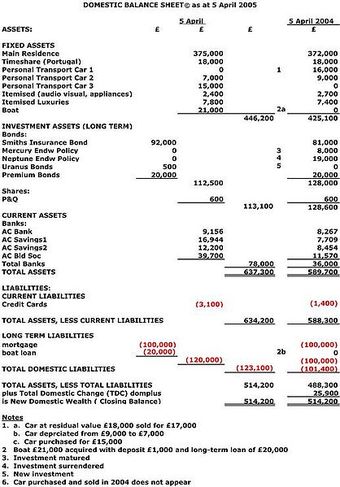
Balance Sheet
Sample Domestic Balance Sheet (DBS) to be referenced by Domestic Well-Being Accounting (DWBA)
Current Assets
A current asset on the balance sheet is an asset which can either be converted to cash or used to pay current liabilities within 12 months. Typical current assets include cash and cash equivalents, short-term investments, accounts receivable, inventories and the portion of prepaid liabilities which will be paid within a year.
Cash and cash equivalents are the most liquid assets found within the asset portion of a company’s balance sheet. Cash equivalents are assets that are readily convertible into cash, such as money market holdings, short-term government bonds or treasury bills, marketable securities and commercial papers. Cash equivalents are distinguished from other investments through their short-term existence; they mature within 3 months whereas short-term investments are 12 months or less, and long-term investments are any investments that mature in excess of 12 months.
Accounts receivable represents money owed by entities to the firm on the sale of products or services on credit. In most business entities, accounts receivable is typically executed by generating an invoice and either mailing or electronically delivering it to the customer, who, in turn, must pay it within an established timeframe, called credit terms or payment terms.
Most manufacturing organizations usually divide their inventory into:
- raw materials – materials and components scheduled for use in making a product,
- work in process (WIP) – materials and components that have began their transformation to finished goods,
- finished goods – goods ready for sale to customers, and
- goods for resale – returned goods that are salable.
A deferred expense or prepayment, prepaid expense (plural often prepaids), is an asset representing cash paid out to a counterpart for goods or services to be received in a later accounting period. For example, if a service contract is paid quarterly in advance, at the end of the first month of the period two months remain as a deferred expense. In the deferred expense, the early payment is accompanied by a related, recognized expense in the subsequent accounting period, and the same amount is deducted from the prepayment.
Non-current Assets
A non-current asset is a term used in accounting for assets and property which cannot easily be converted into cash. This can be compared with current assets such as cash or bank accounts, which are described as liquid assets. Non-current assets include property, plant and equipment (PPE), investment property (such as real estate held for investment purposes), intangible assets, long-term financial assets, investments accounted for by using the equity method, and biological assets, which are living plants or animals.
Property, plant, and equipment normally include items such as land and buildings, motor vehicles, furniture, office equipment, computers, fixtures and fittings, and plant and machinery. These often receive favorable tax treatment (depreciation allowance) over short-term assets.
Intangible assets are defined as identifiable, non-monetary assets that cannot be seen, touched or physically measured. They are created through time and effort, and are identifiable as a separate asset. There are two primary forms of intangibles – legal intangibles (such as trade secrets (e. g., customer lists), copyrights, patents, and trademarks) and competitive intangibles (such as knowledge activities (know-how, knowledge), collaboration activities, leverage activities, and structural activities). The intangible asset “goodwill” reflects the difference between the firm’s net assets and its market value; the amount is first recorded at time of acquisition. The additional value of the firm in excess of its net assets usually reflects the company’s reputation, talent pool, and other attributes that separate it from the competition. Goodwill must be tested for impairment on an annual basis and adjusted if the firm’s market value has changed.
Investments accounted for by using the equity method are 20-50% stake investments in other companies. The investor keeps such equities as an asset on the balance sheet. The investor’s proportional share of the associate company’s net income increases the investment (and a net loss decreases the investment), and proportional payment of dividends decreases it. In the investor’s income statement, the proportional share of the investee’s net income or net loss is reported as a single-line item.
2.3.2: Liabilities and Equity
The balance sheet contains details on company liabilities and owner’s equity.
Learning Objective
Apply the accounting equation to create a balance sheet
Key Points
- In financial accounting, a liability is defined as an obligation of an entity arising from past transactions or events, the settlement of which may result in the transfer or use of assets, provision of services or other yielding of economic benefits in the future.
- Equity is the residual claim or interest of the most junior class of investors in assets, after all liabilities are paid.
- The types of accounts and their description that comprise the owner’s equity depend on the nature of the entity and may include: Common stock, preferred stock, capital surplus, retained earnings, treasury stock, stock options and reserve.
Key Term
- Preferred Stock
-
Stock with a dividend, usually fixed, that is paid out of profits before any dividend can be paid on common stock. It also has priority to common stock in liquidation.
In financial accounting, a liability is defined as an obligation of an entity arising from past transactions or events, the settlement of which may result in the transfer or use of assets, provision of services or other yielding of economic benefits in the future. A liability is defined by the following characteristics:
- Any type of borrowing from persons or banks for improving a business or personal income that is payable during short or long time;
- A duty or responsibility to others that entails settlement by future transfer or use of assets, provision of services, or other transaction yielding an economic benefit, at a specified or determinable date, on occurrence of a specified event, or on demand;
- A duty or responsibility that obligates the entity to another, leaving it little or no discretion to avoid settlement; and,
- A transaction or event obligating the entity that has already occurred.
The accounting equation relates assets, liabilities, and owner’s equity: “” The accounting equation is the mathematical structure of the balance sheet.

Accounting equation
Assets = Liabilities + Owner’s Equity
In accounting and finance, equity is the residual claim or interest of the most junior class of investors in assets, after all liabilities are paid. If liability exceeds assets, negative equity exists. In an accounting context, shareholders’ equity (or stockholders’ equity, shareholders’ funds, shareholders’ capital, or similar terms) represents the remaining interest in assets of a company, spread among individual shareholders of common or preferred stock.
At the start of a business, owners put some funding into the business to finance operations. This creates a liability on the business in the shape of capital, as the business is a separate entity from its owners. Businesses can be considered, for accounting purposes, sums of liabilities and assets: this is the accounting equation. After liabilities have been accounted for, the positive remainder is deemed the owner’s interest in the business.
In financial accounting, owner’s equity consists of the net assets of an entity. Net assets is the difference between the total assets of the entity and all its liabilities. Equity appears on the balance sheet, one of the four primary financial statements.
The assets of an entity includes both tangible and intangible items, such as brand names and reputation or goodwill. The types of accounts and their description that comprise the owner’s equity depend on the nature of the entity and may include: Common stock, preferred stock, capital surplus, retained earnings, treasury stock, stock options and reserve.
The total changes to equity is calculated as follows:
Equity (end of year balance) = Equity (beginning of year balance) +/- changes to common or preferred stock and capital surplus +/- net income/loss (net profit/loss earned during the period) − dividends. Dividends are typically cash distributions of earnings to stockholders on hand and they are recorded as a reduction to the retained earnings account reported in the equity section.
2.3.3: Working Capital
Working capital is a financial metric which represents operating liquidity available to a business, organization and other entity.
Learning Objective
Discuss why working capital is an important metric for businesses.
Key Points
- Net working capital is calculated as current assets minus current liabilities.
- Current assets and current liabilities include three accounts which are of special importance: accounts receivable, accounts payable and inventories.
- The goal of working capital management is to ensure that the firm is able to continue its operations and that it has sufficient cash flow. The management of working capital involves managing inventories, accounts receivable and payable, and cash.
Key Terms
- deficit
-
the amount by which spending exceeds revenue
- operating liquidity
-
The ability of a company or individual to quickly convert assets to cash for the purpose of paying operating expenses.
Working capital (abbreviated WC) is a financial metric which represents operating liquidity available to a business, organization or other entity, including a governmental entity. Along with fixed assets, such as plant and equipment, working capital is considered a part of operating capital.
Net working capital is calculated as current assets minus current liabilities. It is a derivation of working capital, that is commonly used in valuation techniques such as discounted cash flows (DCFs). If current assets are less than current liabilities, an entity has a working capital deficiency, also called a working capital deficit. An increase in working capital indicates that the business has either increased current assets (that it has increased its receivables, or other current assets) or has decreased current liabilities – for example has paid off some short-term creditors.
Current assets and current liabilities include three accounts which are of special importance. These accounts represent the areas of the business where managers have the most direct impact: accounts receivable (current asset), inventories (current assets), and accounts payable (current liability). The current portion of debt (payable within 12 months) is critical, because it represents a short-term claim to current assets and is often secured by long-term assets. Common types of short-term debt are bank loans and lines of credit.
A company can be endowed with assets and profitability but short of liquidity if its assets cannot readily be converted into cash. Decisions relating to working capital and short-term financing are referred to as working capital management. These involve managing the relationship between a firm’s short-term assets and its short-term liabilities. The goal of working capital management is to ensure that the firm is able to continue its operations and that it has sufficient cash flow to satisfy both maturing short-term debt and upcoming operational expenses. The management of working capital involves managing inventories, accounts receivable and payable, and cash.
Inventory management is to identify the level of inventory which allows for uninterrupted production but reduces the investment in raw materials – and minimizes reordering costs – and hence, increases cash flow.
Debtors’ management involves identifying the appropriate credit policies, i.e. credit terms which will attract customers, such that any impact on cash flows and the cash conversion cycle will be offset by increased revenue and hence, return on capital.
Short-term financing requires identifying the appropriate source of financing, given the cash conversion cycle: the inventory is ideally financed by credit granted by the supplier; however, it may be necessary to utilize a bank loan (or overdraft).
Cash management involves identifying the cash balance which allows for the business to meet day-to-day expenses, but reduces cash holding costs.
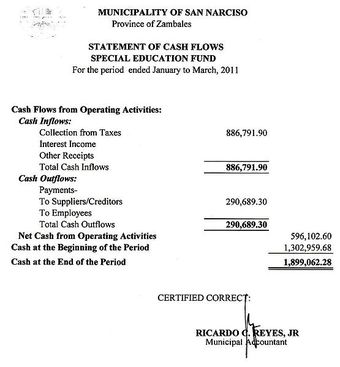
Statement of cash flows
The management of working capital involves managing inventories, accounts receivable and payable, and cash.
2.3.4: Liquidity
Liquidity, a business’s ability to pay obligations, can be assessed using various ratios: current ratio, quick ratio, etc.
Learning Objective
Calculate a company’s liquidity using a variety of methods.
Key Points
- Liquidity refers to a business’s ability to meet its payment obligations, in terms of possessing sufficient liquid assets, and to such assets themselves. For assets, liquidity is an asset’s ability to be sold without causing a significant movement in the price and with minimum loss of value.
- A standard company balance sheet has three parts: assets, liabilities and ownership equity. The main categories of assets are usually listed first, typically in order of liquidity.
- For a corporation with a published balance sheet there are various ratios used to calculate a measure of liquidity, namely the current ratio, the quick ratio, the operating cash flow ratio, and the liquidity ratio (acid test).
Key Terms
- liquidity ratio
-
measurement of the availability of cash to pay debt
- cash equivalents
-
A deferred expense or prepayment, prepaid expense, plural often prepaids, is an asset representing cash paid out to a counterpart for goods or services to be received in a later accounting period.
In accounting, liquidity (or accounting liquidity) is a measure of the ability of a debtor to pay his debts when they fall due. A standard company balance sheet has three parts: assets, liabilities and ownership equity. The main categories of assets are usually listed first, and typically in order of liquidity. Money, or cash, is the most liquid asset, and can be used immediately to perform economic actions like buying, selling, or paying debt, meeting immediate wants and needs. Next are cash equivalents, short-term investments, inventories, and prepaid expenses.
Liquidity also refers both to a business’s ability to meet its payment obligations, in terms of possessing sufficient liquid assets, and to such assets themselves. For assets themselves, liquidity is an asset’s ability to be sold without causing a significant movement in the price and with minimum loss of value.

Liquidity
Monthly liquidity of an organic vegetable business
For a corporation with a published balance sheet, there are various ratios used to calculate a measure of liquidity. These include the following:
- The current ratio, which is the simplest measure and is calculated by dividing the total current assets by the total current liabilities. A value of over 100% is normal in a non-banking corporation. However, some current assets are more difficult to sell at full value in a hurry.
- The quick ratio, which is calculated by deducting inventories and prepayments from current assets and then dividing by current liabilities–this gives a measure of the ability to meet current liabilities from assets that can be readily sold.
- The operating cash flow ratio can be calculated by dividing the operating cash flow by current liabilities. This indicates the ability to service current debt from current income, rather than through asset sales.
- The liquidity ratio (acid test) is a ratio used to determine the liquidity of a business entity. Liquidity ratio expresses a company’s ability to repay short-term creditors out of its total cash. The liquidity ratio is the result of dividing the total cash by short-term borrowings. It shows the number of times short-term liabilities are covered by cash. If the value is greater than 1.00, it means fully covered. The formula is the following: LR = liquid assets / short-term liabilities.
2.3.5: Debt to Equity
The debt-to-equity ratio (D/E) indicates the relative proportion of shareholder’s equity and debt used to finance a company’s assets.
Learning Objective
Identify the different methods of calculating the debt to equity ratio.
Key Points
- The debt-to-equity ratio (D/E) is a financial ratio indicating the relative proportion of shareholders’ equity and debt used to finance a company’s assets. Closely related to leveraging, the ratio is also known as risk, gearing or leverage.
- Preferred stocks can be considered part of debt or equity. Attributing preferred shares to one or the other is partially a subjective decision.
- The formula of debt/ equity ratio: D/E = Debt (liabilities) / equity = Debt / (Assets – Debt) = (Assets – Equity) / Equity.
Key Term
- leverage
-
The use of borrowed funds with a contractually determined return to increase the ability of a business to invest and earn an expected higher return (usually at high risk).
Debt to Equity
The debt-to-equity ratio (D/E) is a financial ratio indicating the relative proportion of shareholders’ equity and debt used to finance a company’s assets. Closely related to leveraging, the ratio is also known as risk, gearing or leverage. The two components are often taken from the firm’s balance sheet or statement of financial position. However, the ratio may also be calculated using market values for both if the company’s debt and equity are publicly traded, or using a combination of book value for debt and market value for equity financially. “”
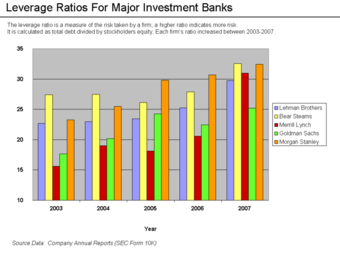
Leverage Ratios of Investment Banks
Each of the five largest investment banks took on greater risk leading up to the subprime crisis. This is summarized by their leverage ratio, which is the ratio of total debt to total equity. A higher ratio indicates more risk.
Preferred stocks can be considered part of debt or equity. Attributing preferred shares to one or the other is partially a subjective decision, but will also take into account the specific features of the preferred shares. When used to calculate a company’s financial leverage, the debt usually includes only the long term debt (LTD). Quoted ratios can even exclude the current portion of the LTD.
Financial analysts and stock market quotes will generally not include other types of liabilities, such as accounts payable, although some will make adjustments to include or exclude certain items from the formal financial statements. Adjustments are sometimes also made, for example, to exclude intangible assets, and this will affect the formal equity; debt to equity (dequity) will therefore also be affected.
The formula of debt/equity ratio: D/E = Debt (liabilities) / equity. Sometimes only interest-bearing long-term debt is used instead of total liabilities in the calculation.
A similar ratio is the ratio of debt-to-capital (D/C), where capital is the sum of debt and equity:D/C = total liabilities / total capital = debt / (debt + equity)
The relationship between D/E and D/C is: D/C = D/(D+E) = D/E / (1 + D/E)
The debt-to-total assets (D/A) is defined asD/A = total liabilities / total assets = debt / (debt + equity + non-financial liabilities)
On a balance sheet, the formal definition is that debt (liabilities) plus equity equals assets, or any equivalent reformulation. Both the formulas below are therefore identical: A = D + EE = A – D or D = A – E
Debt to equity can also be reformulated in terms of assets or debt: D/E = D /(A – D) = (A – E) / E
2.3.6: Market Value vs. Book Value
Book value is the price paid for a particular asset, while market value is the price at which you could presently sell the same asset.
Learning Objective
Distinguish between market value and book value.
Key Points
- Market value is the price at which an asset would trade in a competitive auction setting.
- Book value or carrying value is the value of an asset according to its balance sheet account balance. For assets, the value is based on the original cost of the asset less any depreciation, amortization or impairment costs made against the asset.
- In many cases, the carrying value of an asset and its market value will differ greatly. However, they are interrelated.
Key Term
- amortization
-
The distribution of the cost of an intangible asset, such as an intellectual property right, over the projected useful life of the asset.
Market value is the price at which an asset would trade in a competitive auction setting. Market value is often used interchangeably with open market value, fair value, or fair market value. International Valuation Standards defines market value as “the estimated amount for which a property should exchange on the date of valuation between a willing buyer and a willing seller in an arm’s-length transaction after proper marketing wherein the parties had each acted knowledgeably, prudently, and without compulsion. “
In accounting, book value or carrying value is the value of an asset according to its balance sheet account balance. For assets, the value is based on the original cost of the asset less any depreciation, amortization, or impairment costs made against the asset. An asset’s initial book value is its its acquisition cost or the sum of allowable costs expended to put it into use. Assets such as buildings, land, and equipment are valued based on their acquisition cost, which includes the actual cash price of the asset plus certain costs tied to the purchase of the asset, such as broker fees. The book value is different from market value, as it can be higher or lower depending on the asset in question and the accounting practices that affect book value, such as depreciation, amortization and impairment. In many cases, the carrying value of an asset and its market value will differ greatly. If the asset is valued on the balance at market value, then its book value is equal to the market value.

Depreciation methods which are essential in calculating book value
4 Depreciation methods (1. Straight-Line method, (2. Double-Declining Balance method, (3. Sum-of-the-Years’ Digits method, (4.Productive output method)
Ways of measuring the value of assets on the balance sheet include: historical cost, market value or lower of cost or market. Historical cost is typically the purchase price of the asset or the sum of certain costs expended to put the asset into use. Market value is the asset’s worth if it were to be exchanged in the open market in an arm’s length transaction; it can also be derived based on the asset’s present value of the expected cash flows it will generate. Certain assets are disclosed at lower of cost or market in order to conform to accounting’s conservatism principle, which stresses that assets should never be overstated.
2.3.7: Limitations of the Balance Sheet
The three limitations to balance sheets are assets being recorded at historical cost, use of estimates, and the omission of valuable non-monetary assets.
Learning Objective
Critique the balance sheet
Key Points
- Balance sheets do not show true value of assets. Historical cost is criticized for its inaccuracy since it may not reflect current market valuation.
- Some of the current assets are valued on an estimated basis, so the balance sheet is not in a position to reflect the true financial position of the business.
- The balance sheet can not reflect those assets which cannot be expressed in monetary terms, such as skill, intelligence, honesty, and loyalty of workers.
Key Terms
- carrying value
-
In accounting, book value or carrying value is the value of an asset according to its balance sheet account balance. For assets, the value is based on the original cost of the asset less any depreciation, amortization or Impairment costs made against the asset.
- Fixed assets
-
Fixed assets, also known as non-current assets or property, plant, and equipment (PP&E), is a term used in accounting for assets and property that cannot easily be converted into cash. This can be compared with current assets, such as cash or bank accounts, which are described as liquid assets. In most cases, only tangible assets are referred to as fixed.
Limitations of the Balance Sheet
In financial accounting, a balance sheet or statement of financial position is a summary of the financial balances of a sole proprietorship, business partnership, corporation, or other business organization, such as an LLC or an LLP. Assets, liabilities and ownership equity are listed as of a specific date, such as the end of its financial year. A balance sheet is often described as a “snapshot of a company’s financial condition. ” Of the four basic financial statements, the balance sheet is the only statement which applies to a single point in time of a business’ calendar year. There are three primary limitations to balance sheets, including the fact that they are recorded at historical cost, the use of estimates, and the omission of valuable things, such as intelligence.
Fixed assets are shown in the balance sheet at historical cost less depreciation up to date. Depreciation affects the carrying value of an asset on the balance sheet. The historical cost will equal the carrying value only if there has been no change recorded in the value of the asset since acquisition. Therefore, the balance sheet does not show true value of assets. Historical cost is criticized for its inaccuracy since it may not reflect current market valuation.

Four depreciation methods
Different methods of depreciation affect the carrying value of an asset on balance sheets.
Some of the current assets are valued on estimated basis, so the balance sheet is not in a position to reflect the true financial position of the business. Intangible assets like goodwill are shown in the balance sheet at imaginary figures, which may bear no relationship to the market value. The International Accounting Standards Board (IASB) offers some guidance (IAS 38) as to how intangible assets should be accounted for in financial statements. In general, legal intangibles that are developed internally are not recognized, and legal intangibles that are purchased from third parties are recognized. Therefore, there is a disconnect–goodwill from acquisitions can be booked, since it is derived from a market or purchase valuation. However, similar internal spending cannot be booked, although it will be recognized by investors who compare a company’s market value with its book value.
Finally, the balance sheet can not reflect those assets which cannot be expressed in monetary terms, such as skill, intelligence, honesty, and loyalty of workers.
2.4: Tax Considerations
2.4.1: Corporate Taxes
Corporate taxes are levied on the income of various entities, stemming from their business operations.
Learning Objective
Identify how each type of business association is taxed.
Key Points
- Legal forms of corporations include sole proprietorships, partnerships, C corporations, S corporations, and LLCs.
- The type of corporation chosen will determine such factors as liability and taxation on the entity.
- Taxable income for a corporation is defined as all gross income (sales plus other income minus cost of goods sold and tax exempt income) less allowable tax deductions and tax credits.
Key Term
- jurisdiction
-
the limits or territory within which authority may be exercised
Corporate Taxes
Income taxes in the United States are an enormous and complex issue. Corporate taxes are especially complicated because of the inherent complexities of corporations themselves. Corporations may be taxed on their incomes, property, or their very existence. The types and rates of taxes vary depending on the jurisdiction in which the corporation is organized or acts. Maryland, for example, imposes a tax on corporations organized within its borders based on the number of shares of capital stock they issue.
Legal Forms of Corporations
Corporate taxation differs depending upon the legal form of the corporation. Which legal form to take is driven by the objectives of the company, but taxation also plays a vital role. Tax law contains built-in trade-offs for each corporate form, and companies often must give up some liability protection or flexibility.
Sole Proprietorship
A sole proprietorship is a business entity that is owned and run by a single individual. There is no legal distinction between the owner and the business. They are one in the same for tax purposes. The individual reports all income and expenses for the business on his or her personal income tax statement. In other words, the business is not taxed as a separate entity.
There is no method for sheltering tax in a sole proprietorship. Earnings are taxed regardless if they are actually distributed. In addition, the individual is held liable for the actions of the business, meaning claimants can pursue the personal property of the individual should solvency issues arise.
Partnership
A partnership is a business entity with two or more owners. For tax purposes, partnerships are treated similarly to a sole proprietorship – the owners pay tax on their “distributive share” of the business’s taxable income. The partners must agree on how the income of the business will be allocated. Partners are jointly liable for the operations of the business. Thus, one partner may pursue one or any number of other partners in the case of personal damages or losses.
C Corporation
A C corporation refers to any corporation that is taxed separately from its owners. Although vastly outnumbered by sole proprietorships and partnerships, most of the largest companies in the U.S. are C corporations. Owners of C corporations are personally protected from any liability of the company – an idea known as the corporate veil. In return, the earnings of a C corporation are taxed both on the entity level and the individual level.
S Corporation
The S corporation is a hybrid entity wherein the income, deductions and tax credits of the business are taxed at the shareholder level as opposed to the entity level. However, owners enjoy the same limited liability awarded to C corporations. In exchange for this luxury, rules are placed on the types of corporations that can elect S status:
- The corporation must have only one class of stock.
- It must be a domestic corporation (owned by U.S. citizens).
- It must not have more than 100 shareholders (spouses are considered to be one shareholder).
- Shareholders generally cannot include corporations or partnerships (certain trusts, estates and tax-exempt corporations are permitted).
- Profits and losses must be allocated to shareholders proportionately to each one’s interest in the business.
Limited Liability Company (LLC)
An LLC, like an S corporation, is a hybrid entity having certain characteristics of both a corporation and a partnership or sole proprietorship. The primary characteristic an LLC shares with a corporation is limited liability, and the primary characteristic it shares with a partnership is taxation on the ownership level. It differs from an S corporation in that there are no restrictions on the number or types of shareholders. It is actually a type of unincorporated association rather than a corporation.
Taxable Income
In the United States, taxable income for a corporation is defined as all gross income (sales plus other income minus cost of goods sold and tax exempt income) less allowable tax deductions and tax credits. This income is taxed at a specified corporate tax rate. This rate varies by jurisdiction and is generally the same for different types of income. Some systems have graduated tax rates – corporations with lower levels of income pay a lower rate of tax – or impose tax at different rates for different types of corporations.
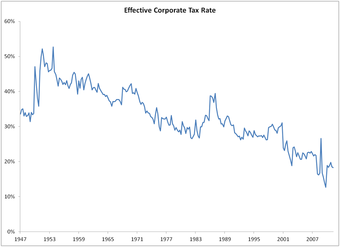
US Corporate Tax Rates
This graph shows the effect of corporate tax rates in the U.S. from 1947 through 2012.
In the US, federal rates range from 15% to 35%. States charge rates ranging from 0% to 10%, deductible in computing federal taxable income. Some cities charge rates up to 9%, also deductible in computing Federal taxable income. Corporations are also subject to property tax, payroll tax, withholding tax, excise tax, customs duties and value added tax. However, these are rarely referred to as “corporate tax.”
2.4.2: Tax Deductions
A tax deduction is a reduction of the amount of income subject to tax.
Learning Objective
Identify deductions associated with carrying on a trade or business
Key Points
- Business expenses are those that are incurred in order to generate profit for a company, such as cost of goods sold.
- Ordinary expenses, such as interest paid on debt, are typically deductible as long as they are appropriate to the nature of the business, the sort expected to help produce income, and are not lavish and extravagant.
- In a progressive tax system, the marginal tax rate must be used in order to calculate the after-tax cost of a deductible expense.
- While a deduction is a reduction of the level of taxable income, a tax credit is a sum deducted from the total amount of tax owed.
Key Term
- capital gains
-
Profit that results from a disposition of a capital asset, such as stock, bond, or real estate due to arbitrage.
Example
- A company’s marginal tax rate is 35%. What is the after-tax cost of a $1,000 of deductible expense? After-tax cost = 1,000 x (1-0.35), so after-tax cost = 650
Tax Deductions
A tax deduction is a sum that can be removed from tax calculations. Specifically, it is a reduction of the income subject to tax. Often these deductions are subject to limitations or conditions. Nearly all jurisdictions that tax business income allow tax deductions for expenses incurred in trading or carrying on the trade or business. However, to be deducted, the expenses must be incurred in furthering the business, such as it must contribute to profit.
Deduction of Expenses
Expenses incurred in order to generate profit for a company are referred to as business expenses. These can be categorized into cost of goods sold and ordinary expenses–also knowns as trading or necessary expenses.
Cost of Goods Sold
Nearly all income tax systems allow a deduction for cost of goods sold. This can be considered an expense or simply a reduction in gross income, which is the starting point for determining Federal and state income tax. Several complexities must be factored in when determining cost of goods sold, including:
- assigning costs to particular goods when specific identification is not feasible;
- attributing common costs, such as factory burden, to particular goods;
- determining when costs are recognized;
- recognizing costs of goods that will not be sold or have declined in value.
Ordinary Expenses
According to tax law, the United States allows as a deduction “all the ordinary and necessary expenses paid or incurred during the taxable year in carrying on any trade or business…” Generally, this business must be regular, continuous, substantial, and entered into with an expectation of profit. Ordinary and necessary expenses tend to be those that are appropriate to the nature of the business, the sort expected to help produce income and promote the business, and those that are not lavish and extravagant.
An example of an ordinary expense is interest paid on debt, or interest expense incurred by a corporation in carrying out its trading activities. Such an expense comes with limitations, though, such as limiting the amount of deductible intrest that can be paid to related parties.
Non-Business Expenses
Expenses incurred from holding assets expected to produce income may also be deductible. For example, a deduction may be allowed for loss on sale, exchange, or abandonment of both business and non-business income producing assets. In the United States, a loss on non-business assets is considered a capital loss and deduction of the loss is limited to capital gains.
Marginal Tax Rate
Corporate taxes in the United States are considered to be progressive. That is to say, taxes are charged at a higher rate as income grows. To fully understand the effect of tax deductions, we must consider the marginal tax rate, which is the rate of tax paid on the next or last unit of currency of taxable income. The marginal tax rate is dependent upon a jurisdiction’s tax structure, usually referred to as tax brackets. To determine the after-tax cost of a deductible expense, we simply multiply the cost by one minus the appropriate marginal tax rate .

Marginal Income Tax Rates
This graph plots the marginal income tax rates for the top tax bracket in the US from 1913 to 2009.
Deductions Versus Credits
Tax deductions and tax credits are often incorrectly equated. While a deduction is a reduction of the level of taxable income, a tax credit is a sum deducted from the total amount of tax owed. It is a dollar-for-dollar tax saving. For example, a tax credit of $1,000 reduced taxes owed by $1,000, regardless of the marginal tax rate. A tax credit may be granted in recognition of taxes already paid, as a subsidy, or to encourage investment or other behaviors.
2.4.3: Depreciation
Depreciation is the allocation of expenses associated with assets that contribute to operations over several periods.
Learning Objective
Describe the effect depreciation has on calculating a company’s tax burden
Key Points
- To determine depreciation expense, the useful life of an asset under depreciation is estimated in time-units. Then the corresponding depreciation rate is calculated that will extinguish the value of the asset from the books when the estimated useful life ends.
- The straight-line method of depreciation reduces the book value of an asset by the same amount each period.
- The declining balance method of depreciation provides for a higher depreciation expense in the first year of an asset’s life and gradually decreases expenses in subsequent years.
- Activity depreciation methods are not based on time but on a level of activity, such as miles driven or cycle counts.
- Depreciation allows a company to properly identify the amount of income it generates in a given period.
Key Terms
- amortize
-
To wipe out (a debt, liability etc. ) gradually or in installments.
- salvage value
-
The estimated value of an asset at the end of its useful life.
Example
- The overall cost for a company’s new piece of machinery is 100,000. The equipment is assumed to have a salvage value at the end of it’s life of 10,000. The useful life of the equipment is expected to be 10 years. If straight-line depreciation is used, what will be the annual depreciation expense? Depreciation = (100,000-10,000) / 10 Depreciation = $9,000
Depreciation
Many tax systems require that the cost of items likely to produce future benefits be capitalized. Such assets include property and capital equipment that represent a commitment of resources over several periods. In accounting, the profits (net income) from an activity must be reduced by the costs associated with that activity. When an asset will be used in operations for several periods, tax systems often allow the allocation of the costs to periods in which the assets are used. In the U.S., this allocation is known as depreciation expense. It is important to reasonably estimate the useful life of the asset under depreciation in time-units. Then it is important to calculate the corresponding depreciation rate that will result in extinguishing the value of the asset from the books when the estimated useful life ends. There are several methods for achieving this goal.
Straight-Line Method
The straight-line method of depreciation reduces the book value of an asset by the same amount each period. This amount is determined by dividing the total value of the asset, less its salvage value, by the number of periods in its useful life. This amount is then deducted from income in each applicable period. Straight-line depreciation is the simplest and most-often-used technique .

Straight-Line Depreciation
Annual depreciation expense is equal to the original cost of the asset minus its salvage value, divided by the useful life of the asset.
The economic reasoning behind the straight-line method involves the acceptance that depreciation is an approximation of the rate at which an asset transfers value to the operations of a business. As a result, we should use the most economical, or simplest, method to calculate and incorporate its costs.
Declining Balance Method
The declining balance method of depreciation provides for a higher depreciation expense in the first year of an asset’s life and gradually decreases expenses in subsequent years. This may be a more realistic reflection of the actual expected benefit from the use of the asset because many assets are most useful when they are new. Under this method, the annual depreciation expense is found by multiplying book value of the asset each year by a fixed rate. Since this book value will differ from year to year, the annual depreciation expense will subsequently differ. The most commonly used rate is double the straight-line rate. Since the declining balance method will never fully amortize the original cost of the asset, the salvage value is not considered in determining the annual depreciation.
Activity Depreciation Methods
Activity depreciation methods are not based on time, but on a level of activity. When the asset is acquired, its life is estimated in terms of this level of activity. This could be miles driven for a vehicle or a cycle count for a machine. Each year, the depreciation expense is calculated by multiplying the rate by the actual activity level.
Effect of Depreciation on Taxes
Depreciation expense affects net income in each period of an asset’s useful life. Therefore, it can be deducted from taxes owed in each of these periods. In other words, depreciation allows a company to properly identify the amount of income it generates in a given period. As with all expenses, a dollar of taxes that a company can defer until later is a dollar that can be used in profit generating operations today.
2.4.4: Individual Taxes
The U.S. federal, state and local governments levy taxes on individuals based on income, property, estate transfers, and/or sales transactions.
Learning Objective
Describe each type of tax that can be imposed on an individual
Key Points
- A direct tax is one imposed upon an individual person or on property, as opposed to an indirect tax that is imposed upon a transaction.
- Income tax is levied on the total income of the individual, less deductions and credits.
- Sales tax is levied on the state level on retail sale, lease, and rental of many goods, as well as some services.
- Property tax is levied on interests in real property (land, buildings, and permanent improvements).
- Estate tax is an excise tax levied on the right to pass property at death.
Key Term
- filing status
-
A status defining the type of tax return form an individual will use, which is based on marital status and family situation.
Individual Taxes
In the United States, there are an assortment of federal, state, local, and special purpose taxes that are imposed by such jurisdictions on individuals in order to finance government operations. These taxes may be imposed on the same income, property, or activity, often without offset of one tax against another. Taxes may be based on property, income, transactions, importation of goods, business activity, or a variety of factors, and are generally imposed on the type of taxpayer for whom such tax base is relevant.
Direct Versus Indirect Taxes
Individual taxes can generally be defined as either direct or indirect. A direct tax is one imposed upon an individual person or on property, as opposed to a tax imposed upon a transaction. In U.S. constitutional law, direct taxes refer to poll taxes and property taxes, which are based on simple existence or ownership. Indirect taxes, such as sales or value-added tax, are imposed only when a taxable transaction occurs. People have the freedom to engage in or refrain from such transactions, whereas a direct tax is typically imposed upon an individual in an unconditional manner.
Individual Tax Categories

Federal Tax Receipts
This chart depicts the level of tax received by the United States federal government from each source in 2010.
Income Tax
Personal income tax is generally the largest source of tax revenue in the United States. Taxes based on income are imposed at the federal, most state, and some local levels. Income tax is levied on the total income of the individual, less deductions, reducing an individual’s taxable income, and credits, a dollar-for-dollar reduction of total tax liability. The tax system allows for personal exemptions, as well as certain “itemized deductions,” including:
- Medical expenses (over 7.5% of adjusted gross income)
- State and local income and property taxes
- Interest expense on certain home loans
- Gifts of money or property to qualifying charitable organizations, subject to certain maximum limitations
- Losses on non-income-producing property due to casualty/theft
- Contribution to certain retirement or health savings plans
- Certain educational expenses
Income tax is often collected on a pay-as-you-earn basis (i.e., witholding taxes from wages). Small corrections are usually made after the end of the tax year. These corrections take one of two forms: payments to the government for taxpayers who have not paid enough during the tax year; and government tax refunds for those who have overpaid.
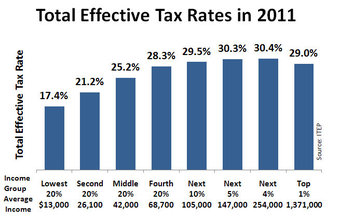
Total Effective Tax Rates
This graph shows the total effective tax rates for each earning class in 2011.
Federal and many state income tax rates are graduated or progressive–they are higher (graduated) at higher levels of income. The income level at which various tax rates apply for individuals varies by filing status. The income level at which each rate starts generally is higher, therefore, tax is lower for married couples filing a joint return or single individuals filing as head of household. Individuals are subject to federal graduated tax rates from 10% to 35%. State income tax rates vary from 1% to 16%, including local income tax where applicable.
Payroll Tax
Payroll taxes are imposed on employers and employees and on various compensation bases. These include income tax witholding, social security and medicare taxes, and unemployment taxes.
Sales Tax
Sales tax is an indirect tax levied on the state level, including taxes on retail sale, lease and rental of goods, as well as some services. Many cities, counties, transit authorities, and special purpose districts impose an additional local sales tax. Sales tax is calculated as the purchase price times the appropriate tax rate. Tax rates vary widely by jurisdiction from less than 1% to over 10%. Nearly all jurisdictions provide numerous categories of goods and services that are exempt from sales tax or taxed at a reduced rate.
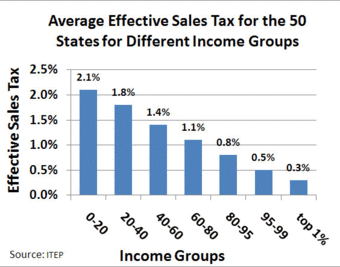
Sales Tax Rates
This graph shows the effective sales tax rates for the 50 states.
In addition to sales tax, excise taxes are imposed at the federal and state levels on a goods, including alcohol, tobacco, tires, gasoline, diesel fuel, coal, firearms, telephone service, air transportation, unregistered bonds, etc.
Property Tax
Most jurisdictions below the state level impose a tax on interests in real property (land, buildings, and permanent improvements). Property tax is based on fair market value the subject property. The amount of tax is determined annually based on the market value of each property on a particular date. The tax is computed as the determined market value times an assessment ratio times the tax rate.
Estate and Gift Tax
The estate tax is an excise tax levied on the right to pass property at death. It is imposed on the estate, not the beneficiary. Gift taxes are levied on the giver (donor) of property where the property is transferred for less than adequate consideration. The Federal gift tax is computed based on cumulative taxable gifts, and is reduced by prior gift taxes paid. The Federal estate tax is computed on the sum of taxable estate and taxable gifts, and is reduced by prior gift taxes paid. These taxes are computed as the taxable amount times a graduated tax rate (up to 35%). Taxable values of estates and gifts are the fair market value.
2.5: The Statement of Cash Flows
2.5.1: Cash Flow from Operations
The operating cash flows refers to all cash flows that have to do with the actual operations of the business, such as selling products.
Learning Objective
Distinguish events that would affect the operating section of the cash flow statement from all of the business’s other transaction
Key Points
- Operating cash flows refers to the cash a company generates from the revenues it brings in, excluding costs associated with long-term investment on capital items or investment in securities (these are investing or financing activities).
- GAAP and IFRS vary in their categorization of many cash flows, such as paying dividends. Some activities that are operating cash flows under one system are financing or investing in another.
- Major operating activities such as manufacturing products or selling a product may appear on the income statement but not on the cash flow statement, because cash has not yet changed hands.
Key Terms
- GAAP
-
Generally Accepted Accounting Principles refer to the standard framework of guidelines, conventions, and rules accountants are expected to follow in recording, summarizing, and preparing financial statements in any given jurisdiction.
- IFRS
-
International Financial Reporting Standards. The major accounting standards system used outside of the United States.
The operating cash flows component of the cash flow statement refers to all cash flows that have to do with the actual operations of the business. It refers to the amount of cash a company generates from the revenues it brings in, excluding costs associated with long-term investment on capital items or investment in securities (these are investing or financing activities). Essentially, it is the difference between the cash generated from customers and the cash paid to suppliers.
Cash flows from operating activities can be calculated and disclosed on the cash flow statement using the direct or indirect method. The direct method shows the cash inflows and outflows affecting all current asset and liability accounts, which largely make up most of the current operations of the entity. Those preparers that use the direct method must also provide operating cash flows under the indirect method. The indirect method is a reconciliation of the period’s net income to arrive at cash flows from operations; changes in current asset and liability accounts are added or subtracted from net income based on whether the change increased or decreased cash. The indirect method must be disclosed in the cash flow statement to comply with U.S. accounting standards, or GAAP.

US GAAP vs. IFRS Cash Flow Classification
Some transactions may be classified as different types of cash flows under GAAP and IFRS accounting standards.
One major difference between GAAP and IFRS is how interest paid is categorized. Under GAAP, a loan payment would have to be broken down into two parts: the payment on principal (financing) and the payment of interest (operating). Under IFRS, it is possible to categorize both as financing cash flows.
All of the major operating cash flows, however, are classified the same way under GAAP and IFRS. The most noticeable cash inflow is cash paid by customers. Cash from customers is not necessarily the same as revenue, though. For example, if a company makes all of its sales by extending credit to customers, it will have generated revenues but not cash flows from customers. It is only when the company collects cash from customers that it has a cash flow.
Significant cash outflows are salaries paid to employees and purchases of supplies. Just as with sales, salaries, and the purchase of supplies may appear on the income statement before appearing on the cash flow statement. Operating cash flows, like financing and investing cash flows, are only accrued when cash actually changes hands, not when the deal is made.
2.5.2: Cash Flow from Investing
Cash flow from investing results from activities related to the purchase or sale of assets or investments made by the company.
Learning Objective
Distinguish investing activities that affect a company’s cash flow statement from the business’s other transactions
Key Points
- Assets included in investment activity include land, buildings, and equipment.
- Receiving dividends from another company’s stock is an investing activity, although paying dividends on a company’s own stock is not.
- An investing activity only appears on the cash flow statement if there is an immediate exchange of cash.
Key Terms
- investing activities
-
actions where money is put into something with the expectation of gain, usually over a longer term
- purchase return
-
merchandise given back to the seller from the buyer after the sale in return for a refund
- investing activity
-
An activity that causes changes in non-current assets or involves a return on investment.
- merger
-
The legal union of two or more corporations into a single entity, typically assets and liabilities being assumed by the buying party.
One of the components of the cash flow statement is the cash flow from investing . An investing activity is anything that has to do with changes in non-current assets — including property and equipment, and investment of cash into shares of stock, foreign currency, or government bonds — and return on investment — including dividends from investment in other entities and gains from sale of non-current assets. These activities are represented in the investing income part of the income statement.
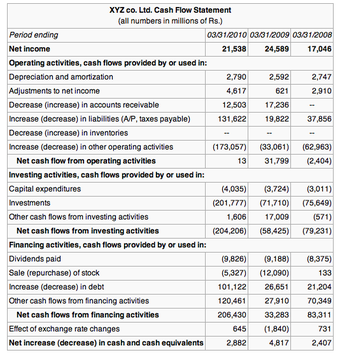
Cash Flow Statement
Example of cash flow statement (indirect method)
It is important to note that investing activity does not concern cash from outside investors, such as bondholders or shareholders. For example, a company may decide to pay out a dividend. A dividend is often thought of as a payment to those who invested in the company by buying its stock. However, this cash flow is not representative of an investing activity on the part of the company. The investing activity was undertaken by the shareholder. Therefore, paying out a dividend is a financing activity.
Some examples of investment activity from the company’s perspective would include:
- Cash outflow from the purchase of an asset (land, building, equipment, etc.).
- Cash inflow from the sale of an asset.
- Cash outflow from the acquisition of another company.
- Cash inflow resulting from a merger.
- Cash inflow resulting dividends paid on stock owned in another company.
It is important to remember that, as with all cash flows, an investing activity only appears on the cash flow statement if there is an immediate exchange of cash. Therefore, extending credit to a customer (accounts receivable) is an investing activity, but it only appears on the cash flow statement when the customer pays off their debt.
2.5.3: Cash Flow from Financing
Cash flows from financing activities arise from the borrowing, repaying, or raising of money.
Learning Objective
Distinguish financing activities that affect a company’s cash flow statement from all of the business’s other transactions
Key Points
- Financing activities can be seen in changes in non-current liabilities and in changes in equity in the change-in-equity statement.
- A positive financing cash flow could be really great for a company (it just went issued stock at a great price) or could be due to the company having to take out loans to stay out of bankruptcy.
- Issuing credit is not a financing activity though taking on credit is. Like all cash flows, such activities only appear on the cash flow statement when the exchange of money actually takes place.
Key Terms
- financing activities
-
actions where money is flowing between the company and investors in the company, such as banks and shareholders
- financing
-
A transaction that provides funds for a business.
Financing Activities
One of the three main components of the cash flow statement is cash flow from financing. In this context, financing concerns the borrowing, repaying, or raising of money. This could be from the issuance of shares , buying back shares, paying dividends, or borrowing cash. Financing activities can be seen in changes in non-current liabilities and in changes in equity in the change-in-equity statement.
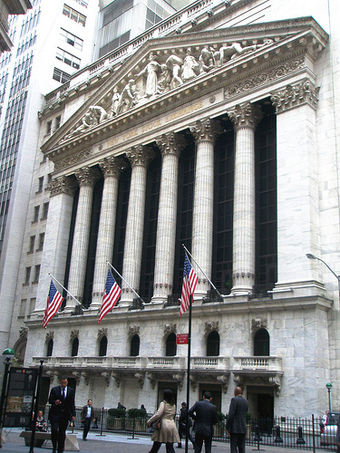
NYSE
The cash from issuing stocks in a market such as the New York Stock Exchange is positive financing cash flow.
On the liability side, a company may take out a loan. Everything concerning the loan is a financing activity. Receiving the money is a positive cash flow because cash is flowing into the company, while each individual payment is a negative cash flow.
However, when a company makes a loan (by extending credit to a customer, for example), it is not partaking in a financing activity. Extending credit is an investing activity, so all cash flows related to that loan fall under cash flows from investing activities, not financing activities.
As is the case with operating and investing activities, not all financing activities impact the cash flow statement — only those that involve the exchange of cash do. For example, a company may issue a discount which is a financing expense. However, because no cash changes hands, the discount does not appear on the cash flow statement.
Overall, positive cash flow could mean a company has just raised cash via a stock issuance or the company borrowed money to pay its obligations, therefore avoiding late payments or even bankruptcy. Regardless, the cash flow statement is an important part of analyzing a company’s financial health, but is not the whole story.
2.5.4: Interpreting Overall Cash Flow
Having positive and large cash flow is a good sign for any business, though does not by itself mean the business will be successful.
Learning Objective
Explain the significance of each component of the Cash Flow Statement
Key Points
- The three types of cash flow are cash from from operations, investing, and financing.
- Having positive cash flows is important because it means that the company has at least some liquidity and may be solvent.
- A positive cash flow does not guarantee that the company can pay all of its bills, just as a negative cash flow does not mean that it will miss its payments.
- When preparing the statement of cash flows, analysts must focus on changes in account balances on the balance sheet.
- Cash flows from operating activities are essential to helping analysts assess the company’s ability to meet ongoing funding requirements, contribute to long-term projects and pay a dividend.
- Analysis of cash flow from investing activities focuses on ratios when assessing a company’s ability to meet future expansion requirements.
- The free cash flow is useful when analysts want to see how much cash can be extracted from a company without causing issues to its day to day operations.
Key Terms
- cash flow
-
The sum of cash revenues and expenditures over a period of time.
- free cash flow
-
net income plus depreciation and amortization, less changes in working capital, less capital expenditure
What is a Cash Flow Statement?
In financial accounting, a cash flow statement (also known as statement of cash flows or funds flow statement) is a financial statement that shows how changes in balance sheet accounts and income affect cash and cash equivalents. The cash flow statement, as the name suggests, provides a picture of how much cash is flowing in and out of the business during the fiscal year.
The cash flow is widely believed to be the most important of the three financial statements because it is useful in determining whether a company will be able to pay its bills and make the necessary investments. A company may look really great based on the balance sheet and income statement, but if it doesn’t have enough cash to pay its suppliers, creditors, and employees, it will go out of business. A positive cash flow means that more cash is coming into the company than going out, and a negative cash flow means the opposite.
Relationship to Other Financial Statements
When preparing the cash flow statement, one must analyze the balance sheet and income statement for the coinciding period. If the accrual basis of accounting is being utilized, accounts must be examined for their cash components. Analysts must focus on changes in account balances on the balance sheet. General rules for this process are as follows.
- Transactions that result in an increase in assets will always result in a decrease in cash flow.
- Transactions that result in a decrease in assets will always result in an increase in cash flow.
- Transactions that result in an increase in liabilities will always result in an increase in cash flow.
- Transactions that result in a decrease in liabilities will always result in a decrease in cash flow
Interpretation
An analyst looking at the cash flow statement will first care about whether the company has a net positive cash flow. Having a positive cash flow is important because it means that the company has at least some liquidity and may be solvent.
Regardless of whether the net cash flow is positive or negative, an analyst will want to know where the cash is coming from or going to . The three types of cash flows (operating, investing, and financing) will all be broken down into their various components and then summed. The company may have a positive cash flow from operations, but a negative cash flow from investing and financing. This sheds important insight into how the company is making or losing money.
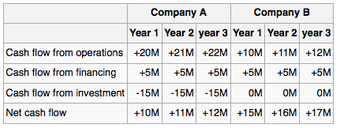
Cash Flow Comparison
Company B has a higher yearly cash flow. However, Company A is actually earning more cash by its core activities and has already spent 45 million dollars in long-term investments, of which revenues will show up after three years.
The analyst will continue breaking down the cash flow statement in this manner, diving deeper and deeper into the specific factors that affect the cash flow. For example, cash flows from operating activities provide feedback on a company’s ability to generate income from internal sources. Thus, these cash flows are essential to helping analysts assess the company’s ability to meet ongoing funding requirements, contribute to long-term projects and pay a dividend.
Analysis of cash flow from investing activities focuses on ratios when assessing a company’s ability to meet future expansion requirements. One such ratio is that for capital acquisitions:
Capital Acquisitions Ratio = cash flow from operating activities / cash paid for property, plant and equipment
This sphere of cash flows also can be used to assess how much cash is available after meeting direct shareholder obligations and capital expenditures necessary to maintain existing capacity.
Free Cash Flows
Free cash flow is a way of looking at a business’s cash flow to see what is available for distribution among all the securities holders of a corporate entity. This may be useful when analysts want to see how much cash can be extracted from a company without causing issues to its day to day operations.
The free cash flow can be calculated in a number of different ways depending on audience and what accounting information is available. A common definition is to take the earnings before interest and taxes, add any depreciation and amortization, then subtract any changes in working capital and capital expenditure.
The free cash flow takes into account the consumption of capital goods and the increases required in working capital. For example in a growing company with a 30 day collection period for receivables, a 30 day payment period for purchases, and a weekly payroll, it will require more and more working capital to finance its operations because of the time lag for receivables even though the total profits has increased.
Free cash flow measures the ease with which businesses can grow and pay dividends to shareholders. Even profitable businesses may have negative cash flows. Their requirement for increased financing will result in increased financing cost reducing future income.
2.6: Other Statements
2.6.1: The Statement of Equity
The statement of equity explains the changes of the company’s equity throughout the reporting period.
Learning Objective
Analyze a company’s statement of equity and retained earnings
Key Points
- The statement breaks down changes in the owners’ interest in the organization. Line items typically include profits or losses from operations, dividends paid, issue or redemption of stock, and any other items charged or credited to retained earnings.
- Owners’ equity = assets − liabilities.
- The statement of equity uses information from the income statement and provides information to the balance sheet.
- Ending retained earnings = beginning retained earnings − dividends paid + net income.
Key Term
- retained earnings
-
The portion of net income that is retained by the corporation rather than distributed to its owners as dividends.
The statement of equity (and similarly the equity statement, statement of owner’s equity for a single proprietorship, statement of partner’s equity for a partnership, and statement of retained earnings and stockholders’ equity for a corporation) are basic financial statements.
These statements explain the changes of the company’s equity throughout the reporting period. They break down changes in the owners’ interest in the organization, and in the application of retained profit or surplus from one accounting period to the next. Line items typically include profits or losses from operations, dividends paid, issue or redemption of stock, and any other items charged or credited to retained earnings.
The statements are expected by generally accepted accounting principles (GAAP) and explain the owners’ equity and retained earnings shown on the balance sheet, where: owners’ equity = assets − liabilities.
A retained earnings statement is required by the U.S. GAAP whenever comparative balance sheets and income statements are presented . It may appear in the balance sheet, in a combined income statement and changes in retained earnings statement, or as a separate schedule. Therefore, the statement of retained earnings uses information from the income statement and provides information to the balance sheet.

The Statement of Retained Earnings and Stockholders’ Equity
The statement of retained earnings uses information from the income statement and provides information to the balance sheet.
Retained earnings are part of the balance sheet under “stockholders equity (shareholders’ equity)” and is mostly affected by net income earned during a period of time by the company minus any dividends paid to the company’s owners and stockholders. The retained earnings account on the balance sheet is said to represent an “accumulation of earnings” since net profits and losses are added / subtracted from the account from period to period.
Retained earnings are part of the statement of changes in equity. The general equation can be expressed as following: ending retained earnings = beginning retained earnings − dividends paid + net income
2.6.2: Depreciation
Depreciation refers to the allocation of the cost of assets to periods in which the assets are used.
Learning Objective
Calculate depreciation expense using different methods
Key Points
- Depreciation refers to the allocation of the cost of assets to periods in which the assets are used (depreciation with the matching principle).
- Generally this involves four criteria: cost of the asset, expected salvage value (residual value of the asset), estimated useful life of the asset, and a method of apportioning the cost over such life.
- There are several methods for calculating depreciation, generally based on either the passage of time or the level of activity of the asset: straight-line depreciation, accelerated depreciation methods, activity depreciation methods, sum-of-years’ digits method, and units-of-production method.
Key Term
- salvage value
-
The estimated value of an asset at the end of its useful life.
Depreciation
Depreciation refers to two very different but related concepts: the decrease in value of assets (fair value depreciation) and the allocation of the cost of assets to periods in which the assets are used (depreciation with the matching principle). The former affects values of businesses and entities. The latter affects net income.
Generally the cost is allocated, as a depreciation expense, among the periods in which the asset is expected to be used. Such expense is recognized by businesses for financial reporting and tax purposes. Methods of computing depreciation may vary by asset for the same business. Several standard methods of computing depreciation expense may be used, such as fixed percentage, straight line, and declining balance methods. Depreciation expense generally begins when the asset is placed in service. Depreciation is generally recognized under historical cost systems of accounting. Generally this involves four criteria: cost of the asset, expected salvage value (residual value of the asset), estimated useful life of the asset, and a method of apportioning the cost over such life.
Calculating Depreciation
There are several methods for calculating depreciation, generally based on either the passage of time or the level of activity or use of the asset.
1. Straight-line depreciation is the simplest and most often used technique, in which the company estimates the salvage value of the asset at the end of the period during which it will be used to generate revenue (useful life). The company will then expense a portion of original cost in equal increments over that period. The salvage value (residual value or scrap value) is an estimate of the value of the asset at the time it will be sold or disposed of.

Depreciation
This is the formula used to calculate straight-line depreciation.
2. Depreciation methods that provide for a higher depreciation charge in the first year of an asset’s life and gradually decrease charges in subsequent years are called accelerated depreciation methods. This may be a more realistic reflection of an asset’s actual expected benefit from the use of the asset: many assets are most useful when they are new. One popular accelerated method is the declining-balance method. Under this method the book value is multiplied by a fixed rate. The most common rate used is double the straight-line rate: Annual Depreciation = Depreciation Rate * Book Value at Beginning of Year.
3. Activity depreciation methods are not based on time, but on a level of activity. This could be miles driven for a vehicle, or a cycle count for a machine. When the asset is acquired, its life is estimated in terms of this level of activity. Each year, the depreciation expense is then calculated by multiplying the rate by the actual activity level.
4. Sum-of-years’ digits is a depreciation method that results in a more accelerated write-off than straight line, but less than the declining-balance method. Under this method, annual depreciation is determined by multiplying the depreciable cost by a schedule of fractions.
- depreciable cost = original cost − salvage value
- book value = original cost − accumulated depreciation
5. Under the units-of-production method, the useful life of the asset is expressed in terms of the total number of units expected to be produced.

Depreciation
This is the units-of-production method for calculating depreciation.
2.6.3: Free Cash Flow
Free cash flow (FCF) is cash flow available for distribution among all the securities holders of an organization.
Learning Objective
Calculate free cash flow using all four methods.
Key Points
- There are four different methods for calculating free cash flows.
- Free cash flow measures the ease with which businesses can grow and pay dividends to shareholders.
- Net income and free cash flows are different. Some investors prefer using free cash flow instead of net income to measure a company’s financial performance because free cash flow is more difficult to manipulate than net income.
Key Terms
- net working capital
-
current assets minus current liabilities
- capital expenditure
-
Funds spent by a company to acquire or upgrade a long-term asset.
- amortization
-
The distribution of the cost of an intangible asset, such as an intellectual property right, over the projected useful life of the asset.
In corporate finance, free cash flow (FCF) is cash flow available for distribution among all the security holders of an organization. They include equity holders, debt holders, preferred stock holders, convertible security holders, and so on. There are four different methods for calculating free cash flows.
1. Free cash flows = EBIT x (1 – Tax rate) + Depreciation & Amortization – Changes in Working Capital – Capital Expenditure
2. Free cash flows = Net profit + Interest expense – Net Capital Expenditure (CAPEX) – Net change in Working Capital – Tax shield on Interest Expense
Where Net Capital Expenditure (CAPEX) = Capex – Depreciation & Amortization and Tax Shield = Net Interest Expense X Effective Tax Rate
3. When Profit after Tax and Debit/Equity ratio (d) is available,
Free cash flows = Profit after Tax – Changes in Capital Expenditure x (1-d) + Depreciation & Amortization x (1-d) – Changes in Working Capital x (1-d)
4. Cash flows from operations = Earnings before Interest and Tax x (1-Tax rate) + Depreciation & Amortization – Changes in Working Capital
Free cash flows = Cash flows from operations – Capital Expenditure “”
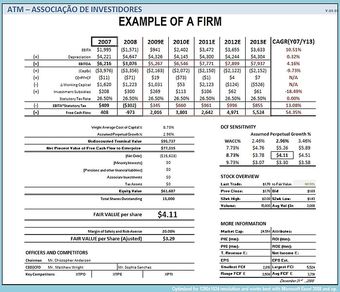
Free Cash Flow
An example of calculating free cash flow.
Free cash flow measures the ease with which businesses can grow and pay dividends to shareholders. Even profitable businesses may have negative cash flows. Their requirement for increased financing will result in increased financing cost reducing future income.
There are two differences between net income and free cash flow. The first is the accounting for the consumption of capital goods. The net income measure uses depreciation, while the free cash flow measure uses last period’s net capital purchases. The second difference is that the free cash flow measurement deducts increases in net working capital, where the net income approach does not. Some investors prefer using free cash flow instead of net income to measure a company’s financial performance because free cash flow is more difficult to manipulate than net income.
2.6.4: MVA and EVA
MVA = PV (EVAs); MVA is the difference between current market value and investors’ capital., and EVA is an estimate of a firm’s economic profit.
Learning Objective
Explain the calculation and results of a business’s MVA and EVA
Key Points
- Market Value Added (MVA) is the difference between the current market value of a firm and the capital contributed by investors.
- Economic Value Added or EVA, is an estimate of a firm’s economic profit – being the value created in excess of the required return of the company’s investors (being shareholders and debt holders).
- The firm’s market value added, or MVA, is the discounted sum (present value) of all future expected economic value added: MVA = Present Value of a series of EVA values.
Key Term
- NOPAT
-
NOPAT (net operating profit after tax) is profits derived from a company’s operations after cash taxes but before financing costs and non-cash bookkeeping entries. It is the total pool of profits available to provide a cash return to those who provide capital to the firm.
Market Value Added
Market Value Added (MVA) is the difference between the current market value of a firm and the capital contributed by investors.
If the MVA is positive, the firm has added value. If it is negative, the firm has deminished value. The amount of value added needs to be greater than the firm’s investors could have achieved investing in the market portfolio, adjusted for the leverage (beta coefficient) of the firm relative to the market. The formula for MVA is:

MVA
Calculation of MVA
where: MVA is market value added, V is the market value of the firm, including the value of the firm’s equity and debt, and K is the capital invested in the firm.
Economic Value Added
In corporate finance, Economic Value Added or EVA, is an estimate of a firm’s economic profit – being the value created in excess of the required return of the company’s investors (being shareholders and debt holders). Quite simply, EVA is the profit earned by the firm, less the cost of financing the firm’s capital. The idea is that value is created when the return on the firm’s economic capital employed is greater than the cost of that capital.
EVA is net operating profit after taxes (or NOPAT) less a capital charge, the latter being the product of the cost of capital and the economic capital.
The basic formula is: EVA = (r – c) * K = NOPAT – c * K
where r is the return on investment capital (ROIC); c is the weighted average of cost of capital (WACC); K is the economic capital employed; NOPAT is the net operating profit after tax.
The firm’s market value added, or MVA, is the discounted sum (present value) of all future expected economic value added: MVA = Present Value of a series of EVA values.

MVA and EVA
MVA is the present value of a series of EVA values.
More enlightening is that, since MVA = NPV of Free cash flow (FCF) it follows, therefore, that the NPV of FCF = PV of EVA since after all, EVA is simply the re-arrangement of the FCF formula.
Chapter 1: Introduction to the Field and Goals of Financial Management
1.1: Introducing Finance
1.1.1: Defining Finance
Finance is the study of fund management and asset allocation over time.
Learning Objective
Explain the importance of time to the discipline of finance
Key Points
- The two main drivers of finance are the time value of money and risk.
- Since the value of assets changes over time, finance seeks to ensure the change is beneficial for the organization or individual.
- Financial professionals generally operate in an environment of uncertainty where they must make forecasts about future events.
Key Terms
- debtor
-
A person or firm that owes money, one in debt, or one who owes a debt.
- asset
-
Something or someone of any value; any portion of one’s property or effects so considered.
- investment
-
A placement of capital in expectation of deriving income or profit from its use.
Overview
Finance is the study of fund management and asset allocation over time. Funds consist of money and other assets. There are many different types of finance, but all are fundamentally concerned with studying how best to allocate assets in different conditions over time.
Importance of Time
The underlying driver behind all of finance is time. There are two reasons why time is so important to finance:
- Time value of money: For a number of reasons, money today is worth more than the same amount of money in the future. For example, you would rather have $100 today than $100 in 10 years – the money is worth more to you now than it would be in the distant future. We will explore this concept in greater depth later on.
- Risk: Making an investment does not guarantee a return. When a bank makes a loan, they’re not sure the debtor will pay it back. There is a risk that the person will just take the money and run, the debtor will file for bankruptcy, or, for dozens of other reasons, the bank will not get the money they lent back.
The field of finance, however, embraces time. Finance says, “Since I know assets change value over time, how do I use that to cause my assets to change value in the direction I want? How do I manage assets so that they’re worth more in the future than they are today? “
Challenges in Finance
Figuring out what to do with assets is sometimes easy: all of the variables are known, and there is clearly an option that is better than all the others. However, most of the time, this is not the case. Finance generally operates with a lot of uncertainty. As a result, companies hire entire departments of people to help them figure out which option is best .

Walmart CFO
Charles Holley, the Chief Financial Officer (CFO) of Wal-Mart, is in charge of making sure all of Wal-Mart’s assets are allocated as optimally as possible.
1.1.2: Comparing the Fields of Finance, Economics, and Accounting
Finance, economics, and accounting are business subjects with many similarities and differences; each is a distinct field of study.
Learning Objective
Recognize how finance, economics and accounting overlap.
Key Points
- Finance is the study of how to optimally allocate assets. Finance is fundamentally a forward looking field, concerned with what an asset will be worth in the future.
- Economics is the social science that analyzes the production, distribution, and consumption of goods and services.
- Accounting is the process of communicating financial information about a business. Accounting is fundamentally a backward-looking field.
Key Term
- return
-
Gain or loss from an investment.
Finance, economics, and accounting are business subjects with many similarities and differences. While they influence each other, each is a distinct field of study.
Finance
Finance is the study of how to optimally allocate assets—how individuals and organizations should invest assets in order to get the highest possible return given changing conditions over time. Finance is fundamentally a forward looking field, concerned with what an asset will be worth in the future.
Economics
Economics is a social science that analyzes the production, distribution, and consumption of goods and services. It focuses on how economic agents (people, businesses, and government) interact and make decisions. Economics is fundamentally the study of cause and effect. It tries to figure out how one variable affects economic agents or the economy as a whole.
Accounting
Accounting focuses on communicating a businesses’ financial information. Accounting is fundamentally a backward-looking field, concerned with what has already happened financially and what position that leaves the company in today.
If accounting is called the language of business, then the financial statements that accountants prepare are the words . Statements are created under a standardized set of accounting laws, which allows one to easily compare and contrast companies. This indicates how financially healthy a company is.
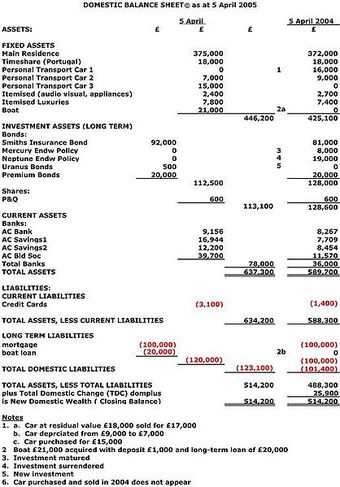
Balance Sheet
The balance sheet is one of the three main financial statements. The other two are the cash flow statement and the income statement.
Overlap
Finance, economics, and accounting overlap in a lot of areas. For example, an investor will use accounting to see whether a company has shown past financial success and to predict what the company will look like in the future. Part of that prediction incorporates economics. The investor wants to know what the overall economy will look like in the future and wants to know how the company will interact with its competitors. The investor can use finance to figure out what his or her investment will be worth in the future.
There are few strong delineators between finance, economics and accounting. All three fields intermingle and influence one another. It is almost impossible to have a strong grasp of one without at least a basic understanding of the other two.
1.1.3: Role of Finance in an Organization
The primary role of corporate finance is to determine how best to maximize shareholder value.
Learning Objective
Define the role of finance in an organization
Key Points
- Maximizing shareholder value can be done over the long-term or the short-term, so the job of the finance department is to determine how best to do both. Sometimes, the goals may appear to contradict each other.
- The finance department is devoted to the task of figuring out how to allocate assets for the overarching goal of maximizing shareholder value. They must ensure that the right assets are in the right place at the right time.
- The finance department must also manage the company’s liabilities so that all projects are financed in an optimal way without taking on too much risk.
Key Terms
- liability
-
An obligation, debt or responsibility owed to someone.
- asset
-
Something or someone of any value; any portion of one’s property or effects so considered.
- shareholder
-
One who owns shares of stock.
Corporate finance is the area of finance dealing with monetary decisions that business enterprises make. When finance is talked about in the context of business decisions, it is called corporate finance (technically, corporate finance deals only with corporations, while managerial finance deals with all types of companies, but we will use the terms interchangeably). There are other branches of finance such as personal finance (individuals taking care of their money) and public finance (the finances of the government).
The primary goal of corporate finance is to maximize shareholder value. Maximizing shareholder value can be done over the long-term or the short-term, so the job of the finance department is to determine how best to do both. Sometimes, the goals may appear to be in competition with one another. For example, a company can choose to pay dividends (a small payment to each person who owns a stock of a company), which increases short-term shareholder wealth. However, paying dividends means that the money is not being invested in long-term investments, which may cause the stock price to increase more in the future, and thereby increasing long-term shareholder wealth.
The technique behind maximizing shareholder value is the management of assets. This means that the finance department figures out how to best invest its money.
For example, a company could have two proposals from the R&D department to develop different products, but only enough money to fund one . The finance department will project out the future revenues and costs of each product and figure out which one, if either, is worth the money.

iPod Touch
Apple used financial analysis to decide to fund the development of the iPod. The money allocated development could not be used for another project, but the finance department determined the iPod was the best option.
Also, the finance department will determine when a company should take on a liability. For example, suppose both projects are absolute home-runs, but the company still only has enough money to fund one. The finance department will figure out if the company should borrow money so that it can fund both.
The role of finance in an organization is to make sure that money is at the right place at the right time. A company wants to have enough money to pay its bills, but also wants to invest so that it can grow in the future. The finance department is devoted to the task of figuring out how to allocate assets to do so, for the overarching goal of maximizing shareholder value.
1.1.4: Types of Financial Decisions: Investment and Financing
Investment and financing decisions boil down to how to spend money and how to borrow money.
Learning Objective
Identify the criteria a corporation must use when making a financial decision
Key Points
- The primary goal of both investment and financing decisions is to maximize shareholder value.
- Investment decisions revolve around how to best allocate capital to maximize their value.
- Financing decisions revolve around how to pay for investments and expenses. Companies can use existing capital, borrow, or sell equity.
Key Terms
- equity
-
Ownership, especially in terms of net monetary value, of a business.
- expected return
-
Considering the magnitude and likelihood of exogenous events, the yield that an investor predicts s/he will earn on average.
- financing
-
A transaction that provides funds for a business.
There are two fundamental types of financial decisions that the finance team needs to make in a business: investment and financing. The two decisions boil down to how to spend money and how to borrow money. Recall that the overall goal of financial decisions is to maximize shareholder value, so every decision must be put in that context.
Investment
An investment decision revolves around spending capital on assets that will yield the highest return for the company over a desired time period. In other words, the decision is about what to buy so that the company will gain the most value.
To do so, the company needs to find a balance between its short-term and long-term goals. In the very short-term, a company needs money to pay its bills, but keeping all of its cash means that it isn’t investing in things that will help it grow in the future. On the other end of the spectrum is a purely long-term view. A company that invests all of its money will maximize its long-term growth prospects, but if it doesn’t hold enough cash, it can’t pay its bills and will go out of business soon. Companies thus need to find the right mix between long-term and short-term investment.
The investment decision also concerns what specific investments to make. Since there is no guarantee of a return for most investments, the finance department must determine an expected return. This return is not guaranteed, but is the average return on an investment if it were to be made many times.
The investments must meet three main criteria:
- It must maximize the value of the firm, after considering the amount of risk the company is comfortable with (risk aversion).
- It must be financed appropriately (we will talk more about this shortly).
- If there is no investment opportunity that fills (1) and (2), the cash must be returned to shareholder in order to maximize shareholder value.
Financing
All functions of a company need to be paid for one way or another. It is up to the finance department to figure out how to pay for them through the process of financing.
There are two ways to finance an investment: using a company’s own money or by raising money from external funders. Each has its advantages and disadvantages.
There are two ways to raise money from external funders: by taking on debt or selling equity. Taking on debt is the same as taking on a loan. The loan has to be paid back with interest, which is the cost of borrowing. Selling equity is essentially selling part of your company . When a company goes public, for example, they decide to sell their company to the public instead of to private investors. Going public entails selling stocks which represent owning a small part of the company. The company is selling itself to the public in return for money.
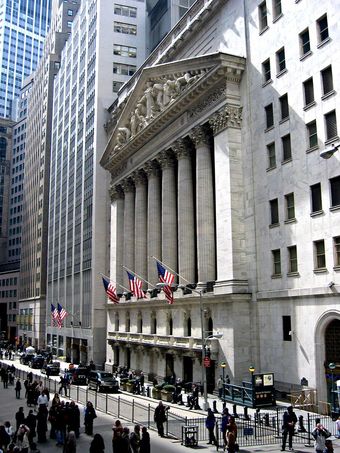
NYSE
If a company chooses to finance an investment by selling equity, they may issue stocks on an exchange like the New York Stock Exchange
Every investment can be financed through company money or from external funders. It is the financing decision process that determines the optimal way to finance the investment.
1.1.5: Functions of Corporate Finance
Corporate finance utilizes tools and analysis to make sound financial business decisions.
Learning Objective
Describe the role of finance in corporation
Key Points
- The finance group is in charge of budgeting. It will look for the optimal allocation of assets across all business functions.
- Corporate finance decides how best to finance projects. The department can either use existing internal funds, borrow money, or sell equity.
- The finance group must balance both short- and long-term company goals, though the overarching goal is to maximize shareholder value.
Key Terms
- investment
-
A placement of capital in expectation of deriving income or profit from its use.
- finance
-
To provide or obtain funding for a transaction or undertaking; to back; to support.
Corporate finance deals with monetary decisions that business enterprises make and the tools and analysis utilized to make the decisions. Corporate finance is concerned primarily with making investment and financing decisions; that is, making sure that money is being used in the best way.
The corporate finance department of a company is in charge of budgeting. Management must allocate limited resources between competing opportunities; since a dollar cannot be used for more than one project at once, it is a challenge to determine how much money should be allocated to each part of the business.
In determining how to allocate money, the finance group must also figure out where the money will be best utilized. This requires valuing projects and business functions. A large element of finance is deciding how exactly to value a project. There are a number of variables – inflation, expected revenues, expected costs, length of time required – that are all incorporated into the valuation process. Finding the true value of a project is often wrought with uncertainty, but without an accurate valuation, a company may allocate its resources sub-optimally.
The corporate finance department must also determine how to finance projects. A company can finance a project by using either internal funds (money the company already has), borrowing, or selling equity. Each option carries a certain cost that can be quantified. It is the job of the finance department to make sure that the overall cost isn’t too high and that the company has an optimal mix of all three strategies.
One public job function of corporate finance is determining whether or not the company pays a dividend, and if so, how much. The company has a responsibility to maximize shareholder value, but that can be achieved in multiple ways. Paying a dividend puts cash directly in the hands of shareholders, increasing shareholder value. However, paying a dividend means that money is not being reinvested in the company. If a company doesn’t pay a dividend and instead chooses to reinvest the money, the value of the company will presumably increase, in turn increasing shareholder value. The finance department determines which option maximizes shareholder value.
Lastly, the finance department must also ensure that there is a good balance between long- and short-term goals. The company must have enough assets to cover short-term costs, referred to as working capital management, and enough invested to ensure the company has long-term growth .

Factory
Purchasing new machinery requires a valuation of all equipment, an accurate idea of the total cost over time, and a way to finance the purchase while leaving enough cash for other upcoming costs.
1.1.6: Overview of the Role of Financial Manager
The financial manager is responsible for budgeting, projecting cash flows, and determining how to invest and finance projects.
Learning Objective
Describe the role and skills of a financial manager
Key Points
- The finance manager is responsible for knowing how much the product is expected to cost and how much revenue it is expected to earn so that s/he can invest the appropriate amount in the product.
- The finance manager uses a number of tools, such as setting the cost of capital (the cost of money over time, which will be explored in further depth later on) to determine the cost of financing.
- The financial manager must not just be an expert at financial projections; s/he also must have a grasp of the accounting systems in place and the strategy of the business over the coming years.
- The head of the financial department is the chief financial officer (CFO) who is responsible for all financial decisions and reporting done in the company.
Key Term
- capital
-
Money and wealth; the means to acquire goods and services, especially in a non-barter system.
The Role of the Financial Manager
The role of a financial manager is a complex one, requiring both an understanding of how the business functions as a whole and specialized financial knowledge. The head of the financial operations is called the chief financial officer (CFO).
The structure of the company varies, but a financial manager is responsible for the same general things across the board. The manager is responsible for managing the budget. This involves allocating money to different projects and segments so that the business can continue operating, but the best projects get the necessary funding.
The manager is responsible for figuring out the financial projections for the business. The development of a new product, for example, requires an investment of capital over time. The finance manager is responsible for knowing how much the product is expected to cost and how much revenue it is expected to earn so that s/he can invest the appropriate amount in the product. This is a lot tougher than it sounds because there is no accurate financial data for the future. The finance manager will use data analyses and educated guesses to approximate the value, but it’s extremely rare that s/he can be 100% sure of the future cash flows.
Figuring out the value of an operation is one thing, but it is another thing to figure out if it’s worth financing. There is a cost to investing money, either the opportunity cost of not investing it elsewhere, the cost of borrowing money, or the cost of selling equity. The finance manager uses a number of tools, such as setting the cost of capital (the cost of money over time, which will be explored in further depth later on) to determine the cost of financing.
At the same time that this is going on, the financial manager must also ensure that the business has enough cash to pay upcoming financial obligations without hoarding assets that could otherwise be invested. This is a delicate dance between short-term and long-term responsibilities.
The CFO is the head of the financial department and is responsible for all of the same things as his/her subordinates, but is also the person who has to sign off that all of the company’s financial statements are accurate. S/he is also responsible for financial planning and record-keeping, as well as financial reporting to higher management.
The financial manager is not just an expert at financial projections, s/he must also have a grasp of the accounting systems in place and the strategy of the business over the coming years .

Collaboration
The finance manager must collaborate across business functions in order to determine how to best allocate and manage assets.
1.1.7: Reasons to Study Finance
Finance is relevant to all business functions, the macroeconomy, and personal finances.
Learning Objective
List the reasons why a person would want to study finance
Key Points
- Finance plays an involved role in the health of the overall economy, which impacts everyone, regardless of whether or not they have studied finance.
- Like companies, individuals are faced with investment and financing decisions. Having a firm grasp of finance will help individuals make those decisions.
- All businesses functions deal with finance because they need to be able to make the financial argument for the funding of their projects and to manage their budgets.
Key Term
- leverage
-
The use of borrowed funds with a contractually determined return to increase the ability of a business to invest and earn an expected higher return (usually at high risk).
The study of finance often feels a lot narrower than it really is. There is a lot of talk of issuing bonds or pricing projects which belies how relevant finance is to everyday life, regardless of whether or not you have any desire of working in finance.
Understanding the Economic Environment
Finance plays an involved role in the health of the overall economy, which impacts everyone, regardless of whether or not they have studied finance. The field of finance explains why the 2008 recession occurred; it is the reason why people care about how the stock market is doing each day ; and it articulates why businesses and governments make some of the decisions they do.

Random Walk
Stock market cannot be predicted.
Finance plays a role in many of the stories in the news every day, which means that those who understand finance have a better grasp on how the events of the world affect them.
Personal Finances
Each person will also have to manage his or her own personal finances. Like corporations, individuals are faced with investment and financing decisions. In order to invest, individuals must be able to do the same projections and valuations as companies in order to determine the best investment for their needs. Individuals cannot sell equity like corporations, but they can choose to either dip into their savings or take out loans. Many take on debt in the form of student loans, mortgages, or through their credit cards; being able to properly compare options to leverage is just as important for individuals as it is for companies.
Application to Business
Of course, finance is an important field of study for those who have a desire of working in finance or accounting. Finance is heavily used in jobs ranging from investment banker to CFO to venture capitalist.
However, finance is not segmented from the other functions in business. Every job from marketing to engineering has to be able to manage a budget and make a business case that it should get funding for a project.
This is especially true higher up in the organizational hierarchy: managers, directors, and vice presidents need to be able to articulate why their departments should get financial support from the company.
Finance is a field of both hard analytical skill and personal judgement. There are set processes and theories for determining which financial option is best, but in the real world, it is rare to have all of the information needed to be absolutely certain about what to do. Finance develops strong analytical skills, but also the degree of finesse required to operate in an environment of uncertainty.

Silver Bid Chart
Finance helps explain what trends in silver bids mean, but more importantly, why people care about them (even those not trading silver).
1.2: Goals of Financial Management
1.2.1: Valuation
Valuation, a goal of financial management, often relies on fundamental analysis of financial statements.
Learning Objective
Describe the valuation process
Key Points
- In finance, valuation is the process of estimating what something is worth. Valuation is used to for a variety of purposes: the purchase or sale of a business, appraisal to resolve disputes, managerial decisions of how to allocate business resources, and many other business and legal purposes.
- Valuation often relies on fundamental financial statement analysis using tools such as discounted cash flow or net present value. As such, an accurate valuation, especially of privately owned companies, largely depends on the reliability of the firm’s historic financial information.
- Not only do managers want to keep reliable financial statements so that they can know the value of their own businesses, but they also want to manage finances well to enhance the value of their businesses to potential buyers, creditors, or investors.
Key Terms
- financial statement
-
A formal record of all relevant financial information of a business, person, or other entity, presented in a structured and standardized manner to allow easy understanding.
- fundamental analysis
-
An analysis of a business with the goal of financial projections in terms of income statement, financial statements and health, management and competitive advantages, and competitors and markets.
- valuation
-
The process of estimating the market value of a financial asset or liability.
Introduction
Financial management focuses on the practical significance of financial numbers. It asks: what do the figures mean? Sound financial management creates value and organizational agility through the allocation of scarce resources among competing business opportunities. It is an aid to the implementation and monitoring of business strategies and helps achieve business objectives. There are several goals of financial management, one of which is valuation .

Valuation
Valuation is, for some, one of the goals of financial management.
Valuation
In finance, valuation is the process of estimating what something is worth. Valuation often relies on fundamental analysis (of financial statements) of the project, business, or firm, using tools such as discounted cash flow or net present value. As such, an accurate valuation, especially of privately owned companies, largely depends on the reliability of the firm’s historic financial information. Items that are usually valued are a financial asset or liability. Valuations can be done on assets (for example, investments in marketable securities such as stocks, options, business enterprises, or intangible assets such as patents and trademarks) or on liabilities (e.g., bonds issued by a company).
Valuation is used to determine the price financial market participants are willing to pay or receive to buy or sell a business. In addition to estimating the selling price of a business, the same valuation tools are often used by business appraisers to resolve disputes related to estate and gift taxation, divorce litigation, allocate business purchase price among business assets, establishing a formula for estimating the value of partners’ ownership interest for buy-sell agreements, and many other business and legal purposes. Therefore, not only do managers want to keep reliable financial statements so that they can know the value of their own businesses, but they also want to manage finances well to enhance the value of their businesses to potential buyers, creditors, or investors.
1.2.2: Maximizing Shareholder and Market Value
A goal of financial management can be to maximize shareholder wealth by paying dividends and/or causing the market value to increase.
Learning Objective
Describe the relationship between shareholder value and market value
Key Points
- One interpretation of proper financial management is that the agents are oriented toward the benefit of the principals, shareholders, and in increasing their wealth by paying dividends and/or causing the stock price or market value to increase.
- The idea of maximizing market value is related to the idea of maximizing shareholder value, as market value is the price at which an asset would trade in a competitive auction setting; for example, returning value to the shareholders if they decide to sell shares or if the firm decides to sell.
- There are many different models of corporate governance around the world. These differ according to the variety of capitalism in which they are embedded. The Anglo-American (US and UK) “model” tends to emphasize the interests of shareholders.
- The sole concentration on shareholder value has been criticized, for concern that a management decision can maximize shareholder value while lowering the welfare of other stakeholders. Additionally, short-term focus on shareholder value can be detrimental to long-term shareholder value.
Key Terms
- shareholder
-
One who owns shares of stock.
- market value
-
The total value of the company as traded in the market. Calculated by multiplying the number of shares outstanding by the price per share.
- principal
-
One who directs another (the agent) to act on one′s behalf.
Introduction
Financial management is concerned with financial matters for the practical significance of the numbers, asking: what do the figures mean? There are several goals of financial management, one of which is maximizing shareholder and market value .

Money to Shareholders
Maximizing shareholder and market value is, for some, one of the goals of financial management.
Maximizing Shareholder Value
The idea of maximizing shareholder value comes from interpretations of the role of corporate governance. Corporate governance involves regulatory and market mechanisms and the roles and relationships between a company’s management, its board, its shareholders, other stakeholders, and the goals by which the corporation is governed.
In large firms where there is a separation of ownership and management and no controlling shareholder, the principal–agent issue arises between upper-management (the “agent”) and shareholders (the “principals”). The danger arises that, rather than overseeing management on behalf of shareholders, the board of directors may become insulated from shareholders and beholden to management.
Thus, one interpretation of proper financial management is that the agents are oriented toward the benefit of the principals – shareholders – in increasing their wealth by paying dividends and/or causing the stock price or market value to increase.
Maximizing Market Value
The idea of maximizing market value is related to the idea of maximizing shareholder value, as market value is the price at which an asset would trade in a competitive auction setting; for example, returning value to the shareholders if they decide to sell shares or if the firm decides to sell.
There are many different models of corporate governance around the world. These differ according to the variety of capitalism in which they are embedded. The Anglo-American (US and UK) “model” tends to emphasize the interests of shareholders.
The sole concentration on shareholder value has been widely criticized, particularly after the late-2000s financial crisis, where attention has risen to the concern that a management decision can maximize shareholder value while lowering the welfare of other stakeholders. Additionally, short-term focus on shareholder value can be detrimental to long-term shareholder value.
1.2.3: Maximizing Value Without Harming Stakeholders
A goal of financial management can be to maximize value without harming stakeholders, the diverse set of parties affected by the business.
Learning Objective
Explain how maximizing value for shareholders can harm the business’s other stakeholders
Key Points
- Stakeholders are those who are affected by an organization’s activities. The stakeholders can be internal or external to the firm and some will be involved directly in economic transactions with the business, while others will not.
- Owners, employees, customers, suppliers, trade unions, the government, local communities, and the environment can be considered stakeholders. Because of the potential breadth of the term, there are different views on whom to include in stakeholder considerations.
- Debate is ongoing about whether firms should be managed for shareholder value maximization or also with stakeholders in mind. While the Anglo-American “model” tends to emphasize shareholders, some European countries formally recognize other stakeholders in corporate governance decisions.
- Some proponents of stakeholder considerations argue that attention to other stakeholders is intimitely intertwined with market value and can enhance outcomes for all stakeholders. Others argue that value should be maximized without harming stakeholders.
Key Terms
- market value
-
The total value of the company as traded in the market. Calculated by multiplying the number of shares outstanding by the price per share.
- stakeholder
-
A person or organisation with a legitimate interest in a given situation, action or enterprise.
Introduction
Professionals in financial management are concerned with the practical significance of the numbers that appear in financial documents. Given a set of information about certain financial behavior, they ask, what do the figures mean? There are several goals of financial management, one of which is maximizing value without harming shareholders.
The Stakeholder Concept
The stakeholder concept is associated with the concept of corporate governance. Corporate governance involves regulatory and market mechanisms and the relationships that exist between a company’s management, its board, its shareholders, other stakeholders, and the goals for which the corporation is governed. Stakeholders are those who are affected by an organization’s activities. The stakeholders can be internal, like owners or employees. They can also be external, like customers, suppliers, the government, local communities, and the environment . Some stakeholders are involved directly in economic transactions with the business. Others are either affected by, or able to affect, an organization’s actions without directly engaging in an economic exchange with the business (for example, trade unions, communities, activist groups, etc). Because of the breadth of the term stakeholder, there are different views as to whom should be included in stakeholder considerations.

Environment as stakeholder
The environment can be seen as a stakeholder. Maximizing value without harming stakeholders is, for some, one of the goals of financial management.
Stakeholders vs. Shareholders
In the field of corporate governance and corporate responsibility, a major debate is currently occurring about whether a firm or company should make decisions chiefly to maximize value for shareholders, or if a company has obligations to other types of stakeholders. This increased after the financial crisis of the late 2000s, when concerns deepened about the potential of companies to lower the welfare of other stakeholders while maximizing their shareholder value. While the Anglo-American (US and UK) business “model” tends to emphasize the interests of shareholders over other implicated parties, some European countries formally recognize other stakeholders in corporate governance decisions.
Some people who argue that businesses should consider other stakeholders, like the government or the environment, argue that an attention to these types of stakeholders is intimately intwined with market value. They also argue that a holistic view can enhance general outcomes for all the stakeholders that are involved. Still others argue that stakeholders, even if they are not considered in business decisions, should at the very least not suffer harm, and that businesses should maximize value only if they can do so without generating harm.
1.3: Trends and Issues in Finance
1.3.1: Current Issues in Finance
Current issues in finance include the economic and regulatory impacts of the financial crisis and the growth of new types of finance.
Learning Objective
Discuss events and trends in finance during the early 21st century
Key Points
- The financial crisis of 2007–2008 caused the near-total collapse of many large financial institutions, the bailout of banks by national governments, and downturns in stock markets around the world.
- Following the financial crisis, various regulatory reforms were passed in the United States, and European regulators introduced Basel III regulations for banks.
- There are various growing areas of finance, including microfinance, crowdfunding, algorithmic trading, and impact investing.
Key Terms
- bailout
-
a rescue, especially a financial rescue
- crowdfunding
-
funding by many individuals pooling their money together for a common goal, usually via the Internet
Financial crisis and regulation
The financial crisis of 2007–2008 caused the near-total collapse of many large financial institutions, the bailout of banks by national governments, and downturns in stock markets around the world. The financial institution crisis hit its peak in late 2008. Several major institutions failed, were acquired under duress, or were subject to government takeover, including Lehman Brothers, Citigroup, Fannie Mae, and Freddie Mac, among several others.The crisis rapidly developed and spread into global economic shock, resulting in a number of European bank failures, economic crises in Iceland, declines in various stock indexes, and large reductions in the market value of equities and commodities. A currency crisis followed, with investors transferring vast capital resources into stronger currencies. In many areas in the United States, the housing market also suffered, resulting in significant numbers of foreclosures. The crisis played a significant role in the failure of key businesses, declines in consumer wealth, prolonged unemployment, and a downturn in economic activity in the United States. It also led to a global recession and a sovereign debt crisis in Europe.
Critics of the financial crisis have argued that the regulatory framework did not keep pace with rapid innovation in financial markets and have asked for increased regulation and enforcement. Various regulatory reforms have been passed in the United States, and European regulators introduced Basel III regulations for banks.
Growing areas of business
Microfinance is the provision of a wide range of financial services, including savings accounts, to the poor. Microcredit is a part of microfinance and involves the extension of very small loans (microloans) to impoverished borrowers, often with the goal of supporting entrepreneurship and/or alleviating poverty.
Peer-to-peer lending over the Internet is another growing development in the financial sector, to which the principles of microcredit have also been applied in attempting to address poverty as well as various non-poverty-related issues. Such efforts include crowdfunding , a term describing the collective effort of individuals who network and pool their resources to support charities initiated by other people or organizations. The rules for crowdfunding are still being developed, and the Securities Exchange Commission has yet to set rules in place for equity crowdfunding campaigns involving unaccredited investors for private companies.

Crowds
One of the newer trends in finance is “crowdfunding. “
Algorithmic trading, now widely used by pension funds, mutual funds, and other institutional traders, is the use of electronic platforms to enter trading orders with an algorithm that calculates aspects such as timing, price, and quantity. Proponents have argued that algorithmic trading substantially improves market liquidity,while critics argue that this type of trading is opaque– a “black box”– and may contribute substantially to market volatility.
The growing field of impact investing refers to investments made based on the practice of assessing not only the financial return on an investment, but also its social and environmental impacts.
1.3.2: Employment in Finance
The financial sector is a large field offering many different types of employment for a broad range of organizations that manage money.
Learning Objective
Identify jobs that require a background in finance
Key Points
- The financial sector is a large field offering many different types of employment. Financial services encompasses a broad range of organizations that manage money, including banks, credit unions, credit card companies, insurers, stock brokerages, and investment funds.
- Financial analysts may work for government investment funds, mutual fund companies, hedge funds, private equity investors, and investment banks. Similarly, credit analysts work in a variety of institutions to assess the creditworthiness of firms, governments, or individuals for loans.
- In insurance, there are insurance brokers and underwriters as well as actuaries and a host of other positions such as insurance claims investigators and agents. Intermediaries exist not just in the insurance business but also as stockbrokers that assist investors in buying and selling shares.
- Finance professionals may also work in public finance, for local or national governments, or in corporate finance. Growth in microfinance and microcredit has also opened up employment opportunities in small-unit finance both in the US and abroad.
- Sophisticated mathematical and technological developments have also advanced the field of quantitative analysis for those who work in investment management, risk management, derivatives pricing, algorithmic trading, and other area that require the application of mathematics in finance.
- Financial employees can come from a variety of backgrounds. Many financial analysis and management positions require some kind of training in finance, accounting, economics, mathematics, engineering, or another quantitative field.
Key Terms
- credit
-
A privilege of delayed payment extended to a buyer or borrower on the seller’s or lender’s belief that what is given will be repaid.
- underwriter
-
An entity which markets newly issued securities
- bank
-
An institution where one can place and borrow money and take care of financial affairs.
The financial sector is a large field offering many different types of employment. Financial services encompasses a broad range of organizations that manage money, including banks, credit unions, credit card companies, insurers, consumer finance companies, stock brokerages, investment funds, some government sponsored enterprises, and other financial institutions, including peer-to-peer lending platforms.
In banking, employees may serve the range of roles needed to run banks, from tellers to financial planners and underwriters to wealth managers. Workers may be employed in a variety of functions by credit card issuers, such as customer service, foreign exchange service, high-profile trading, and airport currency exchangers. Financial analysts may work for government investment funds, mutual fund companies, hedge funds, private equity investors, and investment banks. Credit analysts work in a variety of institutions to assess the creditworthiness of firms, governments, or individuals for loans. In insurance, there are insurance brokers and underwriters as well as actuaries and a host of other positions such as insurance claims investigators and agents.
Intermediaries exist not just in the insurance business. Stockbrokers, for instance, assist investors in buying and selling shares. There are also investors called venture capitalists and angel investors. Finance professionals may also work in public finance, for local or national governments, or in corporate finance.
Growth in microfinance and microcredit has also opened up employment opportunities in finance both in the US and abroad . Sophisticated mathematical and technological developments have also advanced the field of quantitative analysis for those who work in investment management, risk management, derivatives pricing, algorithmic trading, and other areas that require the application of mathematics in finance.

Muhammad Yunus
Muhammad Yunus is a banker who grew a field in microcredit and microfinance, opening up new types of financial employment.
Financial employees can come from a variety of backgrounds. Many financial analysis and management positions require some kind of training in finance, accounting, economics, mathematics, engineering, or another quantitative field. There are Masters degrees in Finance and Business as well as certifications such as the widely recognized Chartered Financial Analyst certification and accountancy qualifications such as the Certified Public Accountant.
1.4: Ethics: An Overview
1.4.1: Defining Ethics
Ethics are the set of moral principles that guide a person’s behavior.
Learning Objective
Define ethics and how it applies to organizations
Key Points
- Ethical behavior is based on written and unwritten codes of principles and values held in society.
- Ethics reflect beliefs about what is right, what is wrong, what is just, what is unjust, what is good, and what is bad in terms of human behavior.
- Ethical principles and values serve as a guide to behavior on a personal level, within professions, and at the organizational level.
Key Terms
- behavior
-
The way a living creature acts.
- ethics
-
The study of principles relating to right and wrong conduct.
- values
-
A collection of guiding principles; what one deems to be correct, important, and desirable in life, especially regarding personal conduct.
Ethics are the set of moral principles that guide a person’s behavior. These morals are shaped by social norms, cultural practices, and religious influences. Ethics reflect beliefs about what is right, what is wrong, what is just, what is unjust, what is good, and what is bad in terms of human behavior. They serve as a compass to direct how people should behave toward each other, understand and fulfill their obligations to society, and live their lives.
While ethical beliefs are held by individuals, they can also be reflected in the values, practices, and policies that shape the choices made by decision makers on behalf of their organizations. The phrases business ethics and corporate ethics are often used to describe the application of ethical values to business activities. Ethics applies to all aspects of conduct and is relevant to the actions of individuals, groups, and organizations.
In addition to individual ethics and corporate ethics there are professional ethics. Professionals such as managers, lawyers, and accountants are individuals who exercise specialized knowledge and skills when providing services to customers or to the public. By virtue of their profession, they have obligations to those they serve. For example, lawyers must hold client conversations confidential and accountants must display the highest levels of honest and integrity in their record keeping and financial analysis. Professional organizations, such as the American Medical Association, and licensing authorities, such as state governments, set and enforce ethical standards.
Example
The concept of corporate social responsibility emphasizes ethical behavior in that it requires organizations to understand, identify, and eliminate unethical economic, environmental, and social behaviors.
1.4.2: Ethics Training
Moral reasoning is the process in which an individual tries to determine what is right and what is wrong.
Learning Objective
Explain the role of ethical moral reasoning in the business environment
Key Points
- There are four components of moral behavior: moral sensitivity, moral judgment, moral motivation, and moral character.
- To make moral assessments, one must first know what an action is intended to accomplish and what its possible consequences will be on others.
- Studies have uncovered four skill sets that play a decisive role in the exercise of moral expertise: moral imagination, moral creativity, reasonableness, and perseverance.
Key Terms
- goodwill
-
The ability of an individual or business to exert influence within a community, club, market, or another type of group, without having to resort to the use of an asset (such as money or property).
- ethics
-
The study of principles relating to right and wrong conduct.
Moral reasoning is the process in which an individual tries to determine the difference between what is right and what is wrong in a personal situation by using logic. To make such an assessment, one must first know what an action is intended to accomplish and what its possible consequences will be on others. People use moral reasoning in an attempt to do the right thing. People are frequently faced with moral choices, such as whether to lie to avoid hurting someone’s feelings, or whether to take an action that will benefit some while harming others. Such judgements are made by considering the objective and the likely consequences of an action. Moral reasoning is the consideration of the factors relevant to making these types of assessments.
According to consultant Lynn W. Swaner, moral behavior has four components:
- Moral sensitivity, which is “the ability to see an ethical dilemma, including how our actions will affect others.”
- Moral judgment, which is “the ability to reason correctly about what ‘ought’ to be done in a specific situation.”
- Moral motivation, which is “a personal commitment to moral action, accepting responsibility for the outcome.”
- Moral character, which is a “courageous persistence in spite of fatigue or temptations to take the easy way out.”
The ability to think through moral issues and dilemmas, then, requires an awareness of a set of moral and ethical values; the capacity to think objectively and rationally about what may be an emotional issue; the willingness to take a stand for what is right, even in the face of opposition; and the fortitude and resilience to maintain one’s ethical and moral standards.
Realizing good conduct, being an effective moral agent, and bringing values into one’s work, all require skills in addition to a moral inclination. Studies have uncovered four skill sets that play a decisive role in the exercise of moral expertise.
- Moral imagination: The ability to see the situation through the eyes of others. Moral imagination achieves a balance between becoming lost in the perspectives of others and failing to leave one’s own perspective. Adam Smith terms this balance “proportionality,” which we can achieve in empathy.
- Moral creativity: Moral creativity is closely related to moral imagination, but it centers on the ability to frame a situation in different ways.
- Reasonableness: Reasonableness balances openness to the views of others with commitment to moral values and other important goals. That is, a reasonable person is open, but not to the extent where he is willing to believe just anything and/or fails to keep fundamental commitments.
- Perseverance: Perseverance is the ability to decide on a moral plan of action and then to adapt to any barriers that arise in order to continue working toward that goal.
Example
William LeMesseur designed the Citicorp Building in New York. When a student identified a critical design flaw in the building during a routine class exercise, LeMesseur responded not by shooting the messenger but by developing an intricate and effective plan for correcting the problem before it resulted in drastic real-world consequences.
1.4.3: Culture and Ethics
Culture reflects the moral values and ethical norms governing how people should behave and interact with others.
Learning Objective
Explain the role of culture in shaping moral and ethical behavior
Key Points
- Culture refers to the outlook, attitudes, values, goals, and practices shared by a group, organization, or society.
- Interpretation of what is moral is influenced by cultural norms, and different cultures can have different beliefs about what is right and wrong.
- According to the theory of cultural relativism, there is no singular truth on which to base ethical or moral behavior, as our interpretations of truths are influenced by our own culture.
Key Terms
- norms
-
Rules or laws that govern a group’s or a society’s behaviors.
- moral relativism
-
Refers to any of several philosophical positions concerned with the differences in moral judgments among different people and across different cultures.
- ethnocentric
-
Of the idea or belief that one’s own culture is more important than, or superior to, other cultures.
Culture describes a collective way of life, or way of doing things. It is the sum of attitudes, values, goals, and practices shared by individuals in a group, organization, or society. Cultures vary over time periods, between countries and geographic regions, and among groups and organizations. Culture reflects the moral and ethical beliefs and standards that speak to how people should behave and interact with others.

Cultural map of the world
This diagram attempts to plot different countries by the importance of different types of values. One axis represents traditional values to secular-rational values, while the other axis accounts for survival values and self-expression values. Different groups of countries can be grouped into certain categories, such as Catholic Europe, English speaking, and Ex-Communist.
Cultural norms are the shared, sanctioned, and integrated systems of beliefs and practices that are passed down through generations and characterize a cultural group. Norms cultivate reliable guidelines for daily living and contribute to the health and well-being of a culture. They act as prescriptions for correct and moral behavior, lend meaning and coherence to life, and provide a means of achieving a sense of integrity, safety, and belonging. These normative beliefs, together with related cultural values and rituals, impose a sense of order and control on aspects of life that might otherwise appear chaotic or unpredictable.
This is where culture intersects with ethics. Since interpretations of what is moral are influenced by cultural norms, the possibility exists that what is ethical to one group will not be considered so by someone living in a different culture. According to cultural relativists this means that there is no singular truth on which to base ethical or moral behavior for all time and geographic space, as our interpretations of truths are influenced by our own culture. This approach is in contrast to universalism, which holds the position that moral values are the same for everyone. Cultural relativists consider this to be an ethnocentric view, as the universal set of values proposed by universalists are based on their set of values. Cultural relativism is also considered more tolerant than universalism because, if there is no basis for making moral judgments between cultures, then cultures have to be tolerant of each other.
Example
The French and Americans have different views on whistle-blowing. Compared to the French, American companies consider it to be a natural part of business. So natural, in fact, that they set up anonymous hotlines. The French, on the other hand, tend to view whistle-blowing as undermining solidarity among coworkers.
1.4.4: The Manager’s Role in Ethical Conduct
Employees can more easily make ethical decisions that promote a company’s values when their personal values match the company’s norms.
Learning Objective
Explain the role of personal values in influencing behavior in organizations
Key Points
- Personal values provide an internal reference for what is good, beneficial, important, useful, beautiful, desirable, and constructive.
- Personal values take on greater meaning in adulthood as they are meant to influence how we carry out our responsibilities to others.
- To make ethical and moral choices, one needs to have a clear understanding of one’s personal values.
Key Terms
- value
-
A standard by which an individual determines what is good or desirable; a measure of relative worth or importance.
- norms
-
According to sociologists, social norms are the laws that govern society’s behaviors.
Personal values provide an internal reference for what is good, beneficial, important, useful, beautiful, desirable, and constructive. Over time, the public expression of personal values has laid the foundations of law, custom, and tradition. Personal values in this way exist in relation to cultural values, either in agreement with or divergent from prevailing norms.
Personal values are developed in many different ways:
- The most important influence on our values comes from the families we grow up with. The family is responsible for teaching children what is right and wrong long before there are other influences. It is thus said that a child is a reflection of his or her parents.
- Teachers and classmates help shape the values of children during the school years.
- Religion (or a lack thereof) also plays a role in teaching children values.
Personal values take on greater meaning in adulthood as they are meant to influence how we carry out our responsibilities to others. This is true in the workplace, especially for managers and leaders, who are charged with overseeing resources for the benefit of others. Because of their authority structures, social norms, and cultures, organizations can have a powerful influence on their employees. Employers do their best to hire individuals who match match well with the organization’s norms and values. In this way they seek to promote their standards of ethical behavior.
Conversely, conflicts can occur between an individual’s moral values and what she perceives to be those of others in their organization. Since moral judgments are based on the analysis of the consequences of behavior, they involve interpretations and assessments. One might be asked to do something that violates a personal belief but is considered appropriate by others. To make ethical and moral choices, one needs to have a clear understanding of one’s personal values. Without that awareness, it can be difficult to justify a decision on ethical or moral grounds in a way that others would find persuasive.
Example
If you value equal rights for all and you go to work for an organization that treats its managers much better than it does its workers, you may form the attitude that the company is an unfair place to work; consequently, you may not produce well or may even leave the company. It is likely that if the company had a more egalitarian policy, your attitude and behaviors would have been more positive.
1.4.5: Blurring Ethical Lines
Ethical decisions involve judgments of facts and situations that are subject to interpretation and other influences.
Learning Objective
Analyze the gray areas of ethical expectations within the context of corporate decision making and ethical business practice
Key Points
- Identifying the ethical choice can be difficult, since many situations are ambiguous and facts are subject to interpretation.
- In organizations, employees can look to the code of ethics or the statement of values for guidance about how to handle ethical gray areas.
- Individual ethical judgement can be clouded by rationalizations to justify one’s actions.
Key Terms
- business ethics
-
The branch of ethics that examines questions of moral right and wrong arising in the context of business practice or theory.
- norms
-
According to sociologists, social norms are the laws that govern society’s behaviors.
Law and ethics are not the same thing. Both exist to influence behavior, but complying with the law is mandatory, while adhering to an ethical code is voluntary. Laws define what is permissible, while ethics speak to what is right, good, and just. Lawyers and judges are responsible for clarifying the meaning of a law when there is ambiguity or when a matter is subject to interpretation. Where ethics are concerned, that responsibility lies with each individual. In organizations, employees can look to the code of ethics or the statement of values for guidance about how to handle ethical gray areas.
Even when an individual has a clear sense of right and wrong, or good and bad, it can be difficult to know what is ethical in a given situation. Ethical choices involve judgment because they involve weighing the potential consequences of one’s actions for other people. One analyzes ethical issues by asking questions such as: What could happen? How likely is it happen? What might the harm be? Who might be hurt? The answers are not always clear cut.
Individual judgments can be influenced, even clouded, by a number of factors. A study by Professor Robert Prentice suggests that self-image can influence an individual’s decision-making process, making him or her feel justified in taking shortcuts or doing things that could be seen as ethically questionable. In addition, there are times when people believe that the ends justify the means. In other words, if the result of an action is good, then it is okay if the action itself is unethical.
There is a saying that a good person is one who does good deeds when no one is looking. The same goes with ethical decisions. People who are ethical follow their beliefs even when they believe no one will find out about what they have done. In many cases of ethical breaches in organizations, those who acted unethically likely believed that they wouldn’t be discovered. Others may have thought that if the issues were discovered, the actions wouldn’t be traced back to them. They had the opportunity to be ethical but chose not to be.
Business Ethics Around the Globe
Social norms aren’t identical in different countries, and ethical standards can vary as well. A business may operate in a country that permits actions that would be considered unethical under that business’s ethical code. How will employees working in that country handle that situation, especially if something that could be considered unethical in one place is actually thought to be important to business success in the other? For instance, in some cultures it is customary for business partners and customers to be invited to weddings, with the expectation that guests will give a cash gift to the bride and groom. A company might consider the gift an unethical bribe in exchange for a customer’s business, yet it may be essential to enter a new market. Adhering to ethical standards in such instances can be difficult.

This way to ethics
Ethical decisions are not always clear-cut.
Example
American companies are often criticized for the treatment of workers who produce their products in China. However, rules concerning the rights of workers are much more relaxed in China than in the United States. Does an American company have the right to order factory owners in China to change their way of doing business? That is one example of an ethical gray area in today’s globalized economy.
1.5: Types of Business Organizations
1.5.1: Overview of Organizational Structure
Business organizations can be structured in various ways, both as legal entities and in terms of internal management processes.
Learning Objective
Select the appropriate organizational structure for a business after reviewing a its key characteristics
Key Points
- From a legal structure perspective, many business structures require a form of incorporation to register the business as a legal entity. The business entity’s type, its geographic span of operations, risk profile, and other factors are issues to consider when choosing what entity type to use.
- There are various forms of organizational structures from a corporate law perspective, including sole proprietorships, cooperatives, partnerships, limited liability companies, and corporations.
- One of the issues dividing the different organizational structures is that of liability. With sole proprietorships and some forms of partnership, owners can be personally liable for business losses, meaning their personal assets are not protected against the claims of creditors.
- Internally, organizations can also be structured differently, in terms of the groupings of organizational relationships and the characteristics of management. Some common structures are the functional, divisional, matrix, team, network, and modular structures.
- Independent from their legal and internal structures, organizations can also operate differently. For example, hybrid organizations, which may fall under various legal categories, can mix elements, value systems and logics of action from the private, public, and voluntary sectors.
Key Terms
- liability
-
An obligation, debt or responsibility owed to someone.
- incorporate
-
To form into a legal company.
- hierarchy
-
Any group of objects ranked so that every one but the topmost is subordinate to a specified one above it.
Organizational Structure
Business organizations can be structured in various ways, depending on their standing as legal entities, internal structure, and management processes .

Organizational chart
A military organizational chart
Pre-bureaucratic structures
Pre-bureaucratic (entrepreneurial) structures lack standardization of tasks. This structure is most common in smaller organizations and is best used to solve simple tasks. The structure is totally centralized and appears like a hierarchy. The strategic leader makes all key decisions and most communication is done by one-on-one conversations. It is particularly useful for new (entrepreneurial) business as it enables the founder to control growth and development.
Bureaucratic structures
Weber said that the fully developed bureaucratic mechanism compares with other organizations exactly as does the machine compare with the non-mechanical modes of production. Precision, speed, unambiguity…strict subordination, reduction of friction and of material and personal costs are raised to the optimum point in the strictly bureaucratic administration. Bureaucratic structures have a certain degree of standardization. They are better suited for more complex or larger scale organizations, usually adopting a tall structure. The tension between bureaucratic structures and non-bureaucratic is echoed in Burns and Stalker’s distinction between mechanistic and organic structures.
Functional structure
Employees within the functional divisions of an organization tend to perform a specialized set of tasks; for instance, the engineering department is staffed only with software engineers. This leads to operational efficiencies within that group. However, it could also lead to a lack of communication between the functional groups within an organization, making the organization slow and inflexible. As a whole, a functional organization is best suited as a producer of standardized goods and services at large volume and low cost.
Divisional structure
Also called a “product structure,” the divisional structure groups each organizational function into a division. Each division within a divisional structure contains all the necessary resources and functions within it. Divisions can be categorized by different points of view. One might make distinctions on a geographical basis (a US division and an EU division, for example) or on product/service basis (different products for different customers, households, or companies). In another example, an automobile company with a divisional structure might have one division for SUVs, another division for subcompact cars, and another for sedans.
Matrix structure
The matrix structure groups employees by both function and product. This structure can combine the best of both separate structures. A matrix organization frequently uses teams of employees to accomplish work, in order to take advantage of strengths and make up for weaknesses of functional and decentralized forms. An example would be a company that produces two products, “product a” and “product b. ” Using the matrix structure, this company would organize functions within the company as follows: “product a” sales department, “product a” customer service department, “product a” accounting department, “product b” sales department, “product b” customer service department, “product b” accounting department. Matrix structure is amongst the purest of organizational structures – a simple lattice emulating order and regularity demonstrated in nature.
Legal considerations
In the US and elsewhere, many business structures require a form of incorporation to register the business as a legal entity. The owner files articles of incorporation with the secretary of state’s office for the particular jurisdiction. The organization may also hold meetings, select a board of directors, adopt bylaws, and report on a regular basis. The business entity’s type, its geographic span of operations, risk profile, and other factors are issues to consider when choosing what entity type to use, in what jurisdiction to incorporate, how the articles should be drafted, and if a stock form should be used.
Business perspective
There are various forms of organizational structures from a business perspective, including sole proprietorships, cooperatives, partnerships, limited liability companies, and corporations. All of these structures are for profit, but there are also non-profit corporations and other structures. The differences in structures can depend on the number of entrepreneurs or owners involved, and the different tax treatments. One of the issues dividing forms is that of liability. With sole proprietorships and some forms of partnership, owners can be personally liable for business losses, meaning their personal assets are not protected against the claims of creditors. These organizational structures are also not separate entities from the owners/entrepreneurs, unlike a corporation.
Organizational behavior
Internally, organizations can also be structured differently, in terms of the groupings of organizational relationships and the characteristics of management. Some common structures are the functional, divisional, matrix, team, network, and modular structures.
Independent from their legal and internal structures, organizations can also behave differently. For example, hybrid organizations, which may fall under various legal categories, can mix elements, value systems, and logics of action from the private, public, and voluntary sectors.
1.5.2: Pros and Cons of Sole Proprietorship
The sole proprietorship structure has the benefit of simplicity and control but the drawback of unlimited liability.
Learning Objective
Describe the key characteristics of a sole proprietorship
Key Points
- The sole proprietorship is a type of business structure open to businesses run and owned by one entrepreneur.
- A large advantage of the sole proprietorship structure is its ease. The sole proprietorship structure does not require filing of articles of incorporation, regular meetings, or election of a board. A sole proprietor also files taxes as personal income.
- The other side of this process is the structure’s main disadvantage: there is no separation between the entrepreneur and the business. This means the sole proprietor is personally liable for business losses. Also, if the proprietor dies, the business ceases to exist.
Key Terms
- proprietor
-
An owner
- entrepreneur
-
A person who organizes and operates a business venture and assumes much of the associated risk.
Overview of Business Structures
Business organizations can be structured in two major ways, namely, in terms of their structures as legal entities and also in terms of the internal structure and management processes. The sole proprietorship is one type of business structure from a legal status perspective. It is a structure open to businesses run and owned by one entrepreneur.

Sole Proprietors
Small businesses are often structured as sole proprietorships.
Sole Proprietorship: Pros and Cons
A large advantage of the sole proprietorship structure is its ease of filing incorporation and tax documents as well as having uninterrupted control of the business. The sole proprietorship is one type of business structure in the US that does not require formal incorporation, meaning that sole proprietors do not need to formally file articles of incorporation, hold regular meetings, or elect an advising or directing board. This simplicity is also reflected in tax treatment, as a sole proprietor files taxes as personal income. Sole proprietors also have control over the aspects of their business without the involvement of elected board members.
On the flip side, the sole proprietorship has one main disadvantage: there is no separation between the entrepreneur and the business. With sole proprietorships, like some forms of partnership, owners can be personally liable for business losses, meaning their personal assets are not protected against the claims of creditors. The sole proprietorship is not a separate entity from the owner/entrepreneur, unlike a corporation. As a result, if the proprietor dies, the business ceases to exist. Because the enterprise rests exclusively on one person, it often has difficulty raising long-term capital.
1.5.3: Pros and Cons of a Partnership
The partnership structure has the benefit of simplicity and control but the drawback of personal liability for the partnership’s activities.
Learning Objective
Describe the legal pros and cons of a partnership
Key Points
- The partnership is a type of business structure open to businesses run and owned by two or more entrepreneurs.
- A large advantage of the partnership structure is its ease, in terms of filing and tax treatment. A general partnership can be started with no special formalities. The partners are taxed individually on their share of the partnership’s profits.
- The structure’s main disadvantage is that partnership owners can be personally liable for business losses. The partnership is not a separate entity from the owners/entrepreneurs, unlike a corporation.
- Types of partnership beyond the general partnership have developed to mitigate some of the disadvantages of the structure. Limited partnerships and limited liability partnerships are two examples.
Key Terms
- liability
-
An obligation, debt or responsibility owed to someone.
- partnership
-
An association of two or more people to conduct a business,
Business Organization Types
Business organizations can be structured in various ways, in terms of their structures as legal entities and also in terms of the internal structure and management processes. The partnership is one type of business structure. The partnership is the next simplest business structure after the sole proprietorship. Because sole proprietors can only have one owner, the partnership is the simplest structure open to collaborative ownership .

Partnership
The partnership is the simplest structure open to collaborative ownership.
Partnership: Pros and Cons
A large advantage of the partnership structure is its ease in filing and tax treatment. With a general partnership, two or more people can start a business as co-owners with no special formalities, directly controlling the partnership and making binding decisions with a simple majority vote. The partners are taxed individually on their share of the partnership’s profits. By default, profits are shared equally among the partners. However, a partnership agreement will almost invariably expressly provide for the manner in which profits and losses are to be shared.
The structure’s main disadvantage is similar to the sole proprietorship. Owners can be personally liable for business losses in some forms of partnership, meaning their personal assets are not protected against the claims of creditors. The partnership is not a separate entity from the owners/entrepreneurs, unlike a corporation. This means that the partnership structure is only as good as the partnership at the relational level. If the mutual consent to form a partnership breaks down, the partnership breaks down as well; partnerships are considered to be an aggregate of their partners rather than a separate entity.
There has been debate in most states as to whether a partnership should remain aggregate or be allowed to become a business entity with a separate continuing legal personality. Types of partnership beyond the general partnership have developed to mitigate some of the disadvantages of the structure. Limited partnerships allow limited liability for some partners who have no management authority, and in some cases (depending on the jurisdiction) limited liability partnerships provide for limited liability for all partners.
1.5.4: Pros and Cons of a Corporation
The corporate structure is less simple to found and maintain but has the advantages of limited liability and perpetual life.
Learning Objective
Distinguish the corporate entity from other types of business organizations
Key Points
- Compared to sole proprietorships and partnerships, the corporation is more complicated to found and maintain, one of its disadvantages. The incorporator must file articles of incorporation as well as hold an organizational meeting to elect a board of directors.
- The structure also generally requires the maintenance of at least annual reporting, including annual financial statements and other data.
- One of the most favorable advantages of the corporate structure is the protection of personal assets of stockholders, directors, and officers. They are limited in liability to the amount they have invested in the corporation.
- Also, because the corporation is an entity separate from its owners, ownership is easily transferable. Similarly, the corporation does not cease to exist with the death of shareholders, directors, or officers of the corporation.
Key Terms
- liability
-
An obligation, debt or responsibility owed to someone.
- incorporate
-
To form into a legal company.
Business organizations can be structured in various ways, in terms of their structures as legal entities and also in terms of the internal structure and management processes. The corporation is one type of business structure.

Exxon Mobil Corporation
One of the world’s largest companies by revenue, it is structured as a corporation.
Corporation: Cons
Compared to other business structures, such as sole proprietorships and partnerships, the corporation is less simple to found and maintain, one of its disadvantages. The incorporator must file articles of incorporation with the secretary of state’s office in the state in which it will be incorporated, as well as hold an organizational meeting to elect a board of directors. The structure also generally requires the maintenance of at least annual reporting. In many jurisdictions corporations, whose shareholders benefit from limited liability, are required to publish annual financial statements and other data, so that creditors who do business with the corporation are able to assess the creditworthiness of the corporation and cannot enforce claims against shareholders. Shareholders, therefore, experience some loss of privacy in return for limited liability. There is also the issue of double taxation, wherein the corporation is taxed on its profits and shareholders are also taxed on their earnings.
Corporation: Pros
One of the most favorable advantages of the corporate structure is the protection of personal assets. Stockholders, directors, and officers of a corporation are typically not liable for the company’s debts and obligations. They are limited in liability to the amount they have invested in the corporation. This limited liability also makes financing more attractive from a risk perspective. Also, because the corporation is an entity separate from its owners, ownership is easily transferable. Similarly, the corporation does not cease to exist with the death of shareholders, directors, or officers of the corporation. Another benefit of the corporate structure is that, in the United States, corporations are generally taxed at a lower rate than are individuals.
Best of Both Worlds: The S Corporation
S corporations are merely corporations that elect to pass corporate income, losses, deductions, and credit through to their shareholders for federal tax purposes. S status combines the legal environment of standard corporations with U.S. federal income taxation similar to that of partnerships. As with partnerships, the income, deductions, and tax credits of an S corporation flow through to shareholders annually, regardless of whether distributions are made. Thus, income is taxed at the shareholder level and not at the corporate level. Payments to S shareholders by the corporation are distributed tax-free to the extent that the distributed earnings were previously taxed. Also, certain corporate penalty taxes (e.g., accumulated earnings tax, personal holding company tax) and the alternative minimum tax do not apply to an S corporation.
1.6: Corporate Governance
1.6.1: Defining Corporate Governance
Corporate governance is the system by which companies are directed and controlled.
Learning Objective
Identify the five major categories of financial disclosures
Key Points
- In contemporary business corporations, the main external stakeholder groups are shareholders, debtholders, trade creditors, suppliers, customers, and communities affected by the corporation’s activities. Internal stakeholders are the board of directors, executives, and other employees.
- Ways of mitigating or preventing these conflicts of interests include the processes, customs, policies, laws, and institutions which have impact on the way a company is controlled.
- A related but separate thread of discussion focuses on the impact of a corporate governance system on economic efficiency, with a strong emphasis on shareholders’ welfare.
- Principles of corporate governance include rights and equitable treatment of shareholders, interests of other stakeholders, role and responsibilities of the board, integrity and ethical behavior, and disclosure and transparency.
Key Terms
- Auditing
-
The general definition of an audit is an evaluation of a person, organization, system, process, enterprise, project or product. The term most commonly refers to audits in accounting, but similar concepts also exist in project management, quality management, water management, and energy conservation.
- stakeholders
-
A corporate stakeholder is that which can affect or be affected by the actions of the business as a whole.
Example
- For example, companies quoted on the London, Toronto, and Australian Stock Exchanges formally need not follow the recommendations of their respective codes. However, they must disclose whether they follow the recommendations in those documents and, where not, they should provide explanations concerning divergent practices. Such disclosure requirements exert a significant pressure on listed companies for compliance.
What is Corporate Governance?
Corporate governance is the system by which companies are directed and controlled. It involves regulatory and market mechanisms; the roles and relationships between a company’s management, its board, its shareholders, and other stakeholders; and the goals for which the corporation is governed. In contemporary business corporations, the main external stakeholder groups are shareholders, debtholders, trade creditors, suppliers, customers, and communities affected by the corporation’s activities. Internal stakeholders are the board of directors, executives, and other employees .

Redisigning corporate governance
Corporate governance deals with the conflicts of interests in a company.
Much of the contemporary interest in corporate governance is concerned with mitigation of the conflicts of interests between stakeholders. Ways of mitigating or preventing these conflicts of interests include the processes, customs, policies, laws, and institutions which have impact on the way a company is controlled. An important theme of corporate governance is the nature and extent of accountability of people in the business.
A related but separate thread of discussion focuses on the impact of a corporate governance system on economic efficiency, with a strong emphasis on shareholders’ welfare. In large firms where there is a separation of ownership and management and no controlling shareholder, the principal–agent issue arises between upper-management (the “agent”) which may have very different interests, and by definition considerably more information, than shareholders (the “principals”). Rather than overseeing management on behalf of shareholders, the board of directors may become insulated from shareholders and beholden to management. This aspect is particularly present in contemporary public debates and developments in regulatory policy.
Principles Of Corporate Governance
Contemporary discussions of corporate governance tend to refer to principles raised in three documents released since 1990: The Cadbury Report (UK, 1992), the Principles of Corporate Governance (OECD, 1998 and 2004), the Sarbanes-Oxley Act of 2002 (US, 2002). The Cadbury and OECD reports present general principals around which businesses are expected to operate to assure proper governance. The Sarbanes-Oxley Act, informally referred to as Sarbox or Sox, is an attempt by the federal government in the United States to legislate several of the principles recommended in the Cadbury and OECD reports.
Rights and Equitable Treatment Of Shareholders
Organizations should respect the rights of shareholders and help shareholders to exercise those rights. They can help shareholders exercise their rights by openly and effectively communicating information and by encouraging shareholders to participate in general meetings.
Interests Of Other Stakeholders
Organizations should recognize that they have legal, contractual, social, and market driven obligations to non-shareholder stakeholders, such as employees, investors, creditors, suppliers, local communities, customers, and policy makers.
Role and Responsibilities Of the Board
The board needs sufficient relevant skills and understanding to review and challenge management performance. It also needs adequate size and appropriate levels of independence and commitment.
Integrity and Ethical Behavior
Integrity should be a fundamental requirement in choosing corporate officers and board members. Organizations should develop a code of conduct for their directors and executives that promotes ethical and responsible decision making.
Disclosure and Transparency
Organizations should clarify and make publicly known the roles and responsibilities of board and management to provide stakeholders with a level of accountability. They should also implement procedures to independently verify and safeguard the integrity of the company’s financial reporting. Disclosure of material matters concerning the organization should be timely and balanced to ensure that all investors have access to clear, factual information.
Codes and Guidelines
Corporate governance principles and codes have been developed in different countries and issued from stock exchanges, corporations, institutional investors, or associations (institutes) of directors and managers with the support of governments and international organizations. As a rule, compliance with these governance recommendations is not mandated by law, although the codes linked to stock exchange listing requirements may have a coercive effect.
One of the most influential guidelines has been the OECD Principles of Corporate Governance—published in 1999 and revised in 2004. The OECD guidelines are often referenced by countries developing local codes or guidelines. Building on the work of the OECD, other international organizations, private sector associations, and more than 20 national corporate governance codes formed the United Nations Intergovernmental Working Group of Experts on International Standards of Accounting and Reporting (ISAR) to produce their Guidance on Good Practices in Corporate Governance Disclosure. This internationally agreed benchmark consists of more than fifty distinct disclosure items across five broad categories:
- Auditing
- Board and management structure and process
- Corporate responsibility and compliance
- Financial transparency and information disclosure
- Ownership structure and exercise of control rights
Most codes are largely voluntary. An issue raised in the U.S. since the 2005 Disney decision is the degree to which companies manage their governance responsibilities. In other words, do they merely try to supersede the legal threshold? Or should they create governance guidelines that ascend to the level of best practice?
1.6.2: Sarbanes–Oxley Act of 2002
The Sarbanes–Oxley Act is a US federal law enhancing standards for all US public company boards, management and public accounting firms.
Learning Objective
Describe the new responsibilities imposed on a corporation by Sarbanes-Oxley
Key Points
- As a result of SOX, top management must now individually certify the accuracy of financial information.
- SOX increased the independence of outside auditors who review the accuracy of corporate financial statements, and increased the oversight role of boards of directors.
- SOX was enacted as a reaction to a number of major corporate and accounting scandals.
- The Sarbanes–Oxley Act includes Auditor Independence, Corporate Responsibility, Enhanced Financial Disclosures, Analyst Conflicts of Interest, Commission Resources and Authority, Corporate and Criminal Fraud Accountability, Corporate Tax Returns, and Corporate Fraud Accountability. .
Key Terms
- conflicts of interest
-
A conflict of interest (COI) occurs when an individual or organization is involved in multiple interests, one of which could possibly corrupt the motivation for an act in the other.
- external auditor
-
An external auditor is an audit professional who performs an audit in accordance with specific laws or rules on the financial statements of a company, government entity, other legal entity or organization, and who is independent of the entity being audited.
Example
- Section 302 requires that the company’s “principal officers” (typically the Chief Executive Officer and Chief Financial Officer) certify and approve the integrity of their company financial reports quarterly.
The Sarbanes–Oxley Act
The Sarbanes–Oxley Act of 2002 is a United States federal law that set new or enhanced standards for all U.S. public company boards, management and public accounting firms. The act is also known as the “Public Company Accounting Reform and Investor Protection Act” (in the Senate) and “Corporate and Auditing Accountability and Responsibility Act” (in the House). It’s more commonly called Sarbanes–Oxley, Sarbox or SOX; it is named after sponsors U.S. Senator Paul Sarbanes (D-MD) and U.S. Representative Michael G. Oxley (R-OH). As a result of SOX, top management must now individually certify the accuracy of financial information. In addition, penalties for fraudulent financial activity are much more severe. Also, SOX increased the oversight role of boards of directors while also increasing the independence of outside auditors who review the accuracy of corporate financial statements.

Sarbanes-Oxley Act
SOX is a United States federal law that set new or enhanced standards for all U.S. public company boards, management and public accounting firms.
The bill was enacted as a reaction to major corporate and accounting scandals affecting Enron, Tyco International and others. These scandals, which cost investors billions of dollars, shook public confidence in the nation’s securities markets.
Debate continues over the perceived benefits and costs of SOX. Opponents of the bill claim it has reduced America’s international competitive edge against foreign financial service providers, saying it introduced an overly complex regulatory environment into U.S. financial markets. Proponents of the measure say that SOX has improved the confidence of fund managers and other investors with regard to the veracity of corporate financial statements.
Public Company Accounting Oversight Board (PCAOB)
Title I consists of nine sections and establishes the Public Company Accounting Oversight Board, providing independent oversight of public accounting firms. It also creates a central oversight board tasked with registering auditors, defining the specific processes for compliance audits, inspecting conduct and quality control, and enforcing compliance.
Auditor Independence
Title II consists of nine sections and establishes standards for external auditor independence. It also addresses new auditor approval requirements, audit partner rotation and auditor reporting requirements. It restricts auditing companies from providing non-audit services (e.g., consulting) for the same clients.
Corporate Responsibility
Title III consists of eight sections mandating that senior executives take individual responsibility for the accuracy and completeness of corporate financial reports. It defines the interaction of external auditors and corporate audit committees, and specifies the responsibility of corporate officers for the accuracy and validity of corporate financial reports.
Enhanced Financial Disclosures
Title IV consists of nine sections. It describes enhanced reporting requirements for financial transactions, including off-balance-sheet transactions, pro-forma figures and stock transactions of corporate officers. It requires internal controls for assuring the accuracy of financial reports and disclosures, and mandates both audits and reports on those controls.
Analyst Conflicts of Interest
Title V consists of only one section, which includes measures designed to help restore investor confidence in reporting of securities analysts. It defines the codes of conduct for securities analysts and requires disclosure of knowable conflicts of interest.
Commission Resources and Authority
Title VI consists of four sections and defines practices to restore investor confidence in securities analysts. It also defines the SEC’s authority to censure securities professionals from practice and defines conditions under which a person can be barred from practicing as a broker, advisor, or dealer.
Studies and Reports
Title VII consists of five sections and requires the Comptroller General and the SEC to perform various studies and report their findings. Studies include the effects of consolidation of public accounting firms and role of credit rating agencies in the operation of securities markets.
Corporate and Criminal Fraud Accountability
Title VIII consists of seven sections and is also referred to as the “Corporate and Criminal Fraud Accountability Act of 2002. ” It describes specific criminal penalties for manipulation, destruction or alteration of financial records, or other interference with investigations, while also providing certain protections for whistleblowers.
White Collar Crime Penalty Enhancement
Title IX consists of six sections. This section increases the criminal penalties associated with white-collar crimes and conspiracies. It recommends stronger sentencing guidelines and specifically adds failure to certify corporate financial reports as a criminal offense.
Corporate Tax Returns
Title X consists of one section. Section 1001 states that the Chief Executive Officer should sign the company tax return.
Corporate Fraud Accountability
Title XI consists of seven sections. Section 1101 recommends a name for this title as “Corporate Fraud Accountability Act of 2002. ” It identifies corporate fraud and records tampering as criminal offenses and joins those offenses to specific penalties. It also revises sentencing guidelines and strengthens their penalties.
1.7: Agency and Conflicts of Interest
1.7.1: Defining Agency Conflicts
Agency conflicts can occur when the incentives of the agent do not align with those of the principal.
Learning Objective
Explain how agency conflicts can influence corporate governance
Key Points
- The agency view of the corporation posits that the decision rights (control) of the corporation are entrusted to the manager to act in shareholders’ interests. Control systems in corporate governance can help align managers’ incentives with those of shareholders and other stakeholders.
- The principal–agent problem concerns the difficulties in motivating one party (the “agent”), to act on behalf of another (the “principal”). The two parties have different interests and asymmetric information. Moral hazard and conflict of interest may thus arise.
- The deviation from the principal’s interest by the agent is called “agency costs. ” Agency costs mainly arise due to contracting costs and the divergence of control, separation of ownership and control, and the different objectives (rather than shareholder maximization) of the managers.
- Much recent interest in corporate governance is concerned with mitigation of the conflicts of interests between stakeholders. These occur when an individual or organization is involved in multiple interests that may lead to conflicts in their ability to act in the best interest of one party.
Key Terms
- moral hazard
-
The prospect that a party insulated from risk may behave differently from the way it would behave if it were fully exposed to the risk.
- agent
-
One who acts for, or in the place of, another (the principal), by authority from him; one intrusted with the business of another; a substitute; a deputy; a factor.
- principal
-
One who directs another (the agent) to act on one′s behalf.
The agency view of the corporation posits that the decision rights (control) of the corporation are entrusted to the manager to act in shareholders’ (and other parties’) interests. Partly as a result of this separation, corporate governance mechanisms include a system of controls intended to help align managers’ incentives with those of shareholders and other stakeholders.
The principal–agent problem or agency dilemma, developed in economic theory, concerns the difficulties in motivating one party (the “agent”), to act on behalf of another (the “principal”). The two parties have different interests and asymmetric information (the agent having more information), such that the principal cannot directly ensure that the agents are always acting in its (the principals’) best interests, particularly when activities that are useful to the principal are costly to the agent, and where elements of what the agent does are costly for the principal to observe. Moral hazard and conflict of interest (COI) may thus arise .

Conflict of Interest
Principal-agent problems – which arise when managers act on the behalf of a firm and its investors – include potential conflicts of interest.
The deviation from the principal’s interest by the agent is called “agency costs. ” Agency costs mainly arise due to contracting costs and the divergence of control, separation of ownership and control, and the different objectives (rather than shareholder maximization) of the managers. When a firm has debt, conflicts of interest can also arise between stockholders and bondholders, leading to agency costs on the firm. Examples of agency costs include that borne by shareholders (the principal), when corporate management (the agent) buys other companies to expand its power instead of maximizing the value of the corporation’s worth; or by the constituents of a politician’s district (the principal) when the politician (the agent) passes legislation helpful to large contributors to their campaign rather than helpful to voters.
Much of the contemporary interest in corporate governance is concerned with mitigation of the conflicts of interests between stakeholders. A conflict of interest occurs when an individual or organization is involved in multiple interests that may lead to conflicts in their ability to act in the best interest of one party. In addition to conflicts of interest between managers, shareholders, and bondholders, conflicts of interest can also occur among other stakeholders of a company, such as the board of directors, employees, government, suppliers, and customers. COI is sometimes termed “competition of interest” rather than “conflict”, emphasizing a connotation of natural competition between valid interests rather than violent conflict. At other times, conflicts of interest are confused with cases that might better be termed “corruption”, such as bribe-taking or fraud.
1.7.2: Managers, Shareholders, and Bondholders
Three parties key to the corporation’s functioning are managers, shareholders, and bondholders, each of which can have different interests.
Learning Objective
Describe the reasons why there may be agency costs in an organization
Key Points
- Three parties key to the functioning of the corporation are the managers, shareholders, and bondholders. While managers control the corporation and make strategic decisions, shareholders are owners, and bondholders are creditors.
- While all three parties have an interest, whether direct or indirect, in the financial performance of the corporation, each of the three parties has different rights and rewards, for example voting rights and forms of financial return.
- Shareholders, managers, and bondholders have different objectives. For example, shareholders have an incentive to take riskier projects than bondholders do and may prefer that the company pay more out in dividends. Managers may also be shareholders or prefer risk-averse, empire-building projects.
Key Terms
- bond
-
A documentary obligation to pay a sum or to perform a contract; a debenture.
- dividend
-
A pro rata payment of money by a company to its shareholders, usually made periodically (e.g., quarterly or annually).
- moral hazard
-
The prospect that a party insulated from risk may behave differently from the way it would behave if it were fully exposed to the risk.
The agency view of the corporation posits that the decision rights (control) of the corporation are entrusted to the manager to act in shareholders’ and other stakeholders’ interests. Partly as a result of this separation, corporate governance mechanisms include a system of controls intended to help align managers’ incentives with those of shareholders and other stakeholders.
The deviation from the principal’s interest by the agent is called ‘agency costs. ‘ Agency costs mainly arise due to contracting costs and the divergence of control, separation of ownership and control and the different objectives of the managers and other stakeholders. Three parties key to the functioning of the corporation are the managers, shareholders, and bondholders. These three parties have different interests and asymmetric information, such that the principals cannot directly ensure that the agents are always acting in its (the principals’) best interests. Moral hazard and conflict of interest may arise.

Working on Assignments
While managers control the corporation and make strategic decisions, shareholders are owners, and bondholders are creditors. While all three parties have an interest, whether direct or indirect, in the financial performance of the corporation, each of the three parties has different rights and rewards, for example voting rights and forms of financial return. Shareholders, managers, and bondholders have different objectives. For example, stockholders have an incentive to take riskier projects than bondholders do, as bondholders are more interested in strategies that will increase the chances of getting their investment back. Shareholders also prefer that the company pay more out in dividends than bondholders would like. Managers may also be shareholders and reap the profits of more risky strategies or may prefer risk-averse empire-building projects.
1.7.3: Conflicts Between Managers and Shareholders
Agency costs mainly occur when ownership is separated, or when managers have objectives other than shareholder value maximization.
Learning Objective
Discuss different examples of a conflict of interest between managers and shareholders
Key Points
- The agency view of the corporation suggests that the decision rights of the corporation should be entrusted to a manager to act in shareholders’ interests. Agency costs mainly occur when ownership is separated, or when managers have objectives other than shareholder value maximization.
- Typically, the CEO and other top executives are responsible for making decisions about high-level policy and strategy. Shareholders, on the other hand, are individuals or institutions that legally own shares of corporation stock. Shareholders typically concede control rights to managers.
- There are various conflicts of interest that can impact manager’s decisions to act in shareholders’ interests. Management may, for example, buy other companies to expand power. Venturing onto fraud, they may even manipulate financial figures to optimize bonuses and stock-price-related options.
- Contemporary discussions of corporate governance argue that corporations should respect the rights of shareholders and help shareholders to exercise those rights. Disclosure and transparency are intimately intertwined with these goals.
Key Term
- shareholder
-
One who owns shares of stock.
The “agency view” of corporations argues that the decisions rights (or control) of a corporation should be entrusted to a manager, so that the manager can act in the interest of shareholders . Partly as a result of this, mechanisms of corporate governance include a system of controls that are intended to align the incentives of managers with those of shareholders.

Two Businessmen Having a Discussion
These two businessmen could represent a manager and shareholder discussing the operation of the business.
The term “agency costs” refers to instances when an agent’s behavior has deviated from a principal’s interest. In this case, the principal would be the shareholder. These types of costs mainly arise because of contracting costs, or because individual managers might only possess partial control of corporation behavior. They also arise when managers have personal objectives that are different from the goal of maximizing shareholder profit.
Typically, the CEO and other top executives are responsible for making decisions about high-level policy and strategy. Shareholders, on the other hand, are individuals or institutions that legally own shares of stock in a corporation. Typically, these people have the right to sell those shares, to vote on directors nominated by various boards, and many other privileges. This being said, shareholders usually concede most of their control rights to managers.
While attempting to benefit shareholders, managers often encounter conflicts of interest. For example, a manager might engage in self-dealing, entering into transactions that benefit themselves over shareholders. Managers might also purchase other companies to expand individual power, or spend money on wasteful pet projects, instead of working to maximize the value of corporation stock. Venturing onto fraud, they may even manipulate financial figures to optimize bonuses and stock-price-related benefits.
The chief goal of current corporate governance is to eliminate instances when shareholders have conflicts of interest with one another. Another important goal is to evaluate whether a corporate governance system hampers or improves the efficiency of an organization. Research of this type is particularly focused on how corporate governance impacts the welfare of shareholders. After the high-profile collapse of a number of large corporations in the past two decades, several of which involved accounting fraud, there has been a renewed public interest in how modern corporations practice governance, particularly regarding accounting.
Advocates of governance typically encourage corporations to respect shareholder rights, and to help shareholders learn how and where to exercise those rights. Disclosure and transparency are intertwined with these goals.
1.7.4: Conflicts of Interest Between Shareholders and Bondholders
The shareholders and bondholders have different rights and returns, leading to potential conflicts of interest.
Learning Objective
Describe the conflict of interest between a company’s shareholders and its bondholders
Key Points
- The shareholders are individuals or institutions that legally own shares of stock in the corporation, while the bondholders are the firm’s creditors. The two parties have different relationships to the company, accompanied by different rights and financial returns.
- Stockholders have an incentive to take riskier projects than bondholders do. Other conflicts of interest can stem from the fact that bonds often have a defined term, or maturity, after which the bond is redeemed, whereas stocks may be outstanding indefinitely but can also be sold at any point.
- Bondholders may put contracts in place prohibiting management from taking on very risky projects or may raise the interest rate demanded, increasing the cost of capital for the company. Conversely, shareholder preferences–for example for riskier growth strategies–can adversely impact bondholders.
Key Terms
- shareholder
-
One who owns shares of stock.
- bond
-
A documentary obligation to pay a sum or to perform a contract; a debenture.
- maturity
-
Date when payment is due.
The agency view of the corporation posits that the decision rights (control) of the corporation are entrusted to the manager (the agent) to act in the principals’ interests.
The deviation from the principals’ interests by the agent is called ‘agency costs’, which are often described as existing between managers and shareholders; but conflicts of interest can also exist between shareholders and bondholders.
The shareholders are individuals or institutions that legally own shares of stock in the corporation, while the bondholders are the firm’s creditors. The two parties have different relationships to the company, accompanied by different rights and financial returns. For example, stockholders have an incentive to take riskier projects than bondholders do , as bondholders are more interested in strategies that will increase the chances of getting their investment back. Shareholders also prefer that the company pay more out in dividends than bondholders would like. Shareholders have voting rights at general meetings, while bondholders do not. If there is no profit, the shareholder does not receive a dividend, while interest is paid to debenture-holders regardless of whether or not a profit has been made. Other conflicts of interest can stem from the fact that bonds often have a defined term, or maturity, after which the bond is redeemed, whereas stocks may be outstanding indefinitely but can also be sold at any point.

Wall Street bull
The bull on Wall Street is an iconic image of the New York Stock Exchange.
Because bondholders know this, they may create ex-ante contracts prohibiting the management from taking on very risky projects that might arise, or they may raise the interest rate demanded, increasing the cost of capital for the company. For example, loan covenants can be put in place to control the risk profile of a loan, requiring the borrower to fulfill certain conditions or forbidding the borrower from undertaking certain actions as a condition of the loan. This can negatively impact the shareholders. Conversely, shareholder preferences–as for example riskier strategies for growth–can adversely impact bondholders.
1.8: Asset Classes
1.8.1: Cash
Cash, the most liquid asset, refers to physical currency such as banknotes and coins.
Learning Objective
Distinguish cash and cash equivalents from other types of assets
Key Points
- Cash refers to physical currency such as banknotes and coins.
- Cash has now become a very small part of the money supply.
- A business operating entirely in cash can measure its profits by withdrawing the entire bank balance at the end of the period, plus any cash in hand.
- Cash and cash equivalents are the most liquid assets found within the asset portion of a company’s balance sheet.
Key Terms
- socio-economic
-
Social economics refers broadly to the use of economics in the study of society.
- money supply
-
In economics, the money supply or money stock is the total amount of monetary assets available in an economy at a specific time.
Cash
In common language, cash refers to physical currency such as banknotes and coins.
In bookkeeping and finance, cash refers to current assets comprising currency or currency equivalents that can be accessed immediately or near-immediately (as in the case of money market accounts). Cash is viewed either as a reserve for payments, in case of a structural or incidental negative cash flow, or as a way to avoid a downturn in financial markets.

Cash
Cash has now become a very small part of the money supply. Its remaining role is to provide a form of currency storage and payment for those who do not wish to take part in other systems, and prefer to make small payments conveniently and promptly. This latter method, however, is being replaced more and more frequently by electronic payment systems.
A business operating entirely in cash can measure its profits by withdrawing the entire bank balance at the end of the period, plus any cash in hand. However, many businesses are not paid immediately; they build up inventories of goods and they acquire buildings and equipment. In other words, because businesses have assets, they cannot immediately turn them into cash at the end of each period. Often, these businesses owe money to suppliers and to tax authorities, and the proprietors do not withdraw all their original capital and profits at the end of each period. This means that businesses also have liabilities. Cash and cash equivalents can be used to pay the short-term debt of a company.
Cash and cash equivalents
Cash and cash equivalents are the most liquid assets found within the asset portion of a company’s balance sheet. Cash equivalents are assets that are readily convertible into cash, such as money market holdings, short-term government bonds or treasury bills, marketable securities, and commercial paper. Cash equivalents are distinguished from other investments through their short-term existence; they mature within 3 months, whereas short-term investments take 12 months or less and long-term investments take longer than 12 months. Cash equivalent investments should also have an insignificant risk of change in value: for example, common stock cannot be considered a cash equivalent, but preferred stock acquired shortly before its redemption date can.
Money
Money is any object or record that is generally accepted as payment for goods and services and repayment of debts in a given socio-economic context or country. The main functions of money can be defined as follows: a medium of exchange; a unit of account; a store of value; and occasionally, in the past, a standard of deferred payment. Any kind of object or secure verifiable record that fulfills these functions can serve as money.
Banknote
A banknote (often known as a bill, paper money, or simply a note) is a type of negotiable instrument known as a promissory note, made by a bank, payable to the bearer on demand. When banknotes were first introduced, they were, in effect, a promise to pay the bearer in coins, but gradually became a substitute for the coins and a form of money in their own right.
1.8.2: Debt
A debt is an obligation owed by one party (the debtor) to a second party (the creditor).
Learning Objective
Classify different types of debt based on its characteristics
Key Points
- A debt is created when a creditor agrees to lend a sum of assets to a debtor. Debt is usually granted with expected repayment.
- The various types of debt can generally be categorized into: 1) secured and unsecured debt, 2) private and public debt, 3) syndicated and bilateral debt, and 4) other types of debt that display one or more of the characteristics noted above.
- Debt allows people and organizations to do things that they would otherwise not be able, or allowed, to do.
Key Term
- TIPS
-
Treasury Inflation-Protected Securities (or TIPS) are the inflation-indexed bonds issued by the U.S. Treasury. The principal is adjusted to the Consumer Price Index (CPI), the commonly used measure of inflation. When the CPI rises, the principal adjusts upward. If the index falls, the principal adjusts downwards.
Debt
A debt is an obligation owed by one party (the debtor) to a second party (the creditor). Debt usually refers to assets granted by the creditor to the debtor, but the term can also be used metaphorically to cover moral obligations and other interactions not based on economic value.
A debt is created when a creditor agrees to lend a sum of assets to a debtor. Debt is usually granted with expected repayment. In modern society, this typically includes repayment of the original sum, plus interest.
In finance, debt is a means of using anticipated future purchasing power in the present before it has actually been earned. Some companies and corporations use debt as a part of their overall corporate finance strategy.
Debt allows people and organizations to do things that they would otherwise not be able, or allowed, to do. People in industrialized nations commonly use it to purchase houses, cars, and many other things too expensive to buy with cash on hand. Companies also use debt in many ways to leverage the investment made in their assets, by “leveraging” the return on their equity. This leverage, the proportion of debt to equity, is considered important in determining the riskiness of an investment–the more debt per equity, the riskier. For both companies and individuals, this increased risk can lead to poor results, as the cost of servicing the debt can grow beyond the ability to pay due to either external events (income loss) or internal difficulties (poor management of resources).
Types of debt
A company uses various kinds of debt to finance its operations. The various types of debt can generally be categorized into:
1) secured and unsecured debt
A debt obligation is considered secured if creditors have recourse to the assets of the company on a proprietary basis or otherwise ahead of general claims against the company. Unsecured debt comprises financial obligations, where creditors do not have recourse to the assets of the borrower to satisfy their claims.
2) private and public debt
Private debt involves bank-loan type obligations, whether senior or mezzanine. Public debt is a general definition covering all the financial instruments that are freely tradeable on a public exchange or over the counter, with few if any restrictions.
3) syndicated and bilateral debt
A syndicated loan is a loan that is granted to companies that wish to borrow more money than any single lender is prepared to risk in a single loan, an amount usually in the many millions of dollars. In such a case, a syndicate of banks can each agree to put forward a portion of the principal sum. Loan syndication is a risk management tool that allows the lead banks underwriting the debt to reduce their risk and free up lending capacity.
4) other types of debt
A bond is a debt security issued by certain institutions such as companies and governments. A bond entitles the holder to repayment of the principal sum, plus interest. Bonds are issued to investors in a marketplace when an institution wishes to borrow money. Bonds have a fixed lifetime, usually a number of years. Some long-term bonds, can last over 30 years, though they are less common. At the end of the bond’s life the money should be repaid in full. Interest may be added to the end payment or can be paid in regular installments (known as coupons) during the life of the bond. Bonds may be traded in the bond markets and are widely used as relatively safe investments in comparison to equity.
Borrowing and repayment arrangements linked to inflation-indexed units of account are possible and are used in some countries. For example, the US government issues two types of inflation-indexed bonds, Treasury Inflation-Protected Securities (TIPS) and I-bonds. Inflation-indexed debt is one of the safest forms of investment available, since the only major source of risk – that of inflation – is eliminated. A number of other governments issue similar bonds, with some doing so for many years before the US government. In countries with consistently high inflation, ordinary borrowings at banks may also be inflation indexed.

Treasury Bills
Treasury bills are one kind of debt issued by the U.S. Treasury.
1.8.3: Stocks
The capital stock (or stock) of a business entity represents the original capital paid into or invested in the business by its founders.
Learning Objective
Distinguish between preferred and common shares of stock
Key Points
- The capital stock (or stock) of a business entity represents the original capital paid into or invested in the business by its founders. It serves as a security for the creditors of a business since it cannot be withdrawn to the detriment of the creditors.
- Stock typically takes the form of shares of either common stock or preferred stock.
- As a unit of ownership, common stock typically carries voting rights that can be exercised in corporate decisions; Preferred stock differs from common stock in that it typically does not carry voting rights but is legally entitled to receive a certain level of dividend payments before any dividends can be issued to other shareholders.
- In general, the shares of a company may be transferred from shareholders to other parties by sale or other mechanisms, unless prohibited.
Key Term
- Initial public offering
-
An initial public offering (IPO) or stock market launch is a type of public offering where shares of stock in a company are sold to the general public, on a securities exchange, for the first time.
Example
- Preferred stock usually comes with a letter designation at the end of the security; for example, Berkshire-Hathaway Class “B” shares sell under stock ticker BRK.B whereas Class “A” shares of ORION DHC, Inc will sell under ticker OODHA until the company drops the “A” creating ticker OODH for its “Common” shares only designation.
Stock
The capital stock (or stock) of a business entity represents the original capital paid into or invested in the business by its founders. It serves as a security for the creditors of a business since it cannot be withdrawn to the detriment of the creditors. Stock is different from the property and the assets of a business which may fluctuate in quantity and value.
The stock of a business is divided into multiple shares, the total of which must be stated at the time of business formation. Given the total amount of money invested in the business, a share has a certain declared face value, commonly known as the par value of a share. The par value is the de minimis (minimum) amount of money that a business may issue and sell shares for in many jurisdictions and it is the value represented as capital in the accounting of the business. In other jurisdictions, however, shares may not have an associated par value at all. Such stock is often called non-par stock. Shares represent a fraction of ownership in a business. A business may declare different types (classes) of shares, each having distinctive ownership rules, privileges, or share values.
Types of stock
Stock typically takes the form of shares of either common stock or preferred stock.
- As a unit of ownership, common stock typically carries voting rights that can be exercised in corporate decisions.
- Preferred stock differs from common stock in that it typically does not carry voting rights but is legally entitled to receive a certain level of dividend payments before any dividends can be issued to other shareholders.
- Convertible preferred stock is preferred stock that includes an option for the holder to convert the preferred shares into a fixed number of common shares, usually any time after a predetermined date. Shares of such stock are called “convertible preferred shares”.
New equity issues may have specific legal clauses attached that differentiate them from previous issues of the issuer. Some shares of common stock may be issued without the typical voting rights, for instance, or some shares may have special rights unique to them and issued only to certain parties. Often, new issues that have not been registered with a securities governing body may be restricted from resale for certain periods of time.
Preferred stock may be hybrid by having the qualities of bonds of fixed returns and common stock voting rights. They also have preference in the payment of dividends over common stock and also have been given preference at the time of liquidation over common stock. They have other features of accumulation in dividend. In addition, preferred stock usually comes with a letter designation at the end of the security. This extra letter does not mean that any exclusive rights exist for the shareholders but it does let investors know that the shares are considered for such, however, these rights or privileges may change based on the decisions made by the underlying company.
Application
The owners of a private company may want additional capital to invest in new projects within the company. They may also simply wish to reduce their holding, freeing up capital for their own private use. They can achieve these goals by selling shares in the company to the general public, through a sale on a stock exchange. This process is called an initial public offering, or IPO.
By selling shares they can sell part or all of the company to many part-owners. The purchase of one share entitles the owner of that share to literally share in the ownership of the company, a fraction of the decision-making power, and potentially a fraction of the profits, which the company may issue as dividends.
Trading
In general, the shares of a company may be transferred from shareholders to other parties by sale or other mechanisms, unless prohibited. Most jurisdictions have established laws and regulations governing such transfers, particularly if the issuer is a publicly traded entity.
The desire of stockholders to trade their shares has led to the establishment of stock exchanges, organizations which provide marketplaces for trading shares and other derivatives and financial products. Today, stock traders are usually represented by a stockbroker who buys and sells shares of a wide range of companies on such exchanges. A company may list its shares on an exchange by meeting and maintaining the listing requirements of a particular stock exchange. In the United States, through the intermarket trading system, stocks listed on one exchange can often also be traded on other participating exchanges, including electronic communication networks (ECNs), such as Archipelago or Instinet.

Stock Market Prices
Stock prices vary according to supply and demand for the stocks in question.
1.9: Financial Markets
1.9.1: Types of Financial Markets
Financial markets are of many types, including general and specialized; capital and money; and primary and secondary.
Learning Objective
Describe different types of financial markets
Key Points
- A financial market is an aggregate of possible buyers and sellers of financial securities, commodities, and other fungible items, as well as the transactions between them.
- The term “financial markets” is often used to refer solely to the markets that are used to raise finance: for long-term finance, capital markets are used; for short-term finance (maturity up to one year), money markets are used.
- Stock markets and bond markets are two types of capital markets that provide financing through the issuing of shares of stock or the issuing of bonds, respectively. A key division within the capital markets is between the primary markets and secondary markets.
- While capital markets and money markets constitute the narrower definition of financial markets, other markets, such as derivatives and currency markets, are often included in the more general sense of the word.
Key Terms
- derivative
-
A financial instrument whose value depends on the valuation of an underlying asset; such as a warrant, an option, etc.
- maturity
-
Date when payment is due.
- capital
-
Money and wealth; the means to acquire goods and services, especially in a non-barter system.
- fungible
-
Able to be substituted for something of equal value or utility; interchangeable, exchangeable, replaceable
A financial market is an aggregate of possible buyers and sellers of financial securities, commodities, and other fungible items, as well as the transactions between them. Examples of financial markets include capital markets, derivative markets, money markets, and currency markets. There are many different ways to divide and classify financial markets: for example, into general markets and specialized markets, capital markets and money markets, and primary and secondary markets.
Within the financial sector, the term “financial markets” is often used to refer solely to the markets that are used to raise finance:
- for long-term finance, capital markets are used
- for short-term finance (maturity up to one year), money markets are used.
Stock markets and bond markets are two types of capital markets that provide financing through the issuing of shares of stock and the issuing of bonds, respectively. A key division within the capital markets is between the primary markets and secondary markets. Newly formed (issued) securities are bought or sold in primary markets, such as during initial public offerings. Secondary markets are for the secondary trade of securities, providing a continuous and regular market for the buying and selling of securities.

The New York Stock Exchange
The New York Stock Exchange (NYSE) is an exchange enabling a financial market.
While capital markets and money markets constitute the narrower definition of financial markets, other markets are often included in the more general sense of the word. The derivatives market is the financial market for derivatives– financial instruments like futures contracts or options– which are derived from other forms of assets. Currency markets, enabled by foreign exchange (or forex) markets enable currency conversion and determine the relative value of world currencies.
1.9.2: Role of Financial Markets in Capital Allocation
One of the main functions of financial markets is to allocate capital, matching those who have capital to those who need it.
Learning Objective
Explain how financial markets allocates capital
Key Points
- One of the main functions of financial markets is to allocate capital. Capital markets especially facilitate the raising of capital while money markets facilitate the transfer of liquidity, in both cases matching those who have capital to those who need it.
- Financial markets attract funds from investors and channel them to enterprises that use that capital to finance their operations and achieve growth, from startup phases to expansion–even much later in the firm’s life.
- Without financial markets, borrowers would have difficulty finding lenders themselves. Intermediaries such as banks help in this process. Bank deposits are a simple way in which capital is allocated from a pool of savers to businesses that want to deploy it.
- More complex transactions than a simple bank deposit require markets where lenders and their agents can meet borrowers and their agents, and where existing instruments can be resold. One example being a stock exchange.
Key Terms
- exchange
-
A place for conducting trading.
- capital
-
Money and wealth; the means to acquire goods and services, especially in a non-barter system.
- liquidity
-
Availability of cash over short term: ability to service short-term debt.
Introduction
A financial market is an aggregate of possible buyers and sellers of financial securities, commodities, and other fungible items and the transactions between them . Within the financial sector, the term “financial markets” is often used to refer just to the markets that are used to raise finance: the capital markets for long-term finance and the money markets for short-term finance (maturity up to one year).

Frankfurt Bond Market
The Frankfurt Bond Market is an example of a financial market that allocates capital.
Allocating Capital
One of the main functions of financial markets is to allocate capital. Capital markets especially facilitate the raising of capital while money markets facilitate the transfer of liquidity, matching those who have capital to those who need it. Financial markets attract funds from investors and channel them to enterprises that use that capital to finance their operations and achieve growth, from start-up phases to expansion–even much later in the firm’s life. Money markets allow firms to borrow funds on a short-term basis, while capital markets allow corporations to gain long-term funding to support expansion.
Funds borrowed from the money markets are typically used for general operating expenses, to cover brief periods of illiquidity. When a company borrows from the primary capital markets, often the purpose is to invest in additional physical capital goods, which will be used to help increase its income. Financial capital is money used by entrepreneurs and businesses to buy what they need to make their products or provide their services. It can take many months or years before the investment generates sufficient return to pay back its cost, and hence the finance is long-term. Long-term capital can come in the form of shared capital, mortgage loans, and venture capital, among other types.
Without financial markets, borrowers would have difficulty finding lenders themselves. Intermediaries such as banks help in this process. Banks take deposits from those who have money to save. Many individuals are not aware that they are lenders providing capital, but many do lend money at least indirectly, for example when they put money in a savings account or contribute to a pension. Intermediaries like banks can then lend money from this pool of deposited money in the form of loans to those who seek to borrow. More complex transactions than a simple bank deposit require markets where lenders and their agents can meet borrowers and their agents, and where existing borrowing or lending commitments can be sold on to other parties. One example is the stock exchange, where a company can raise money by selling ownership shares to investors and its existing shares can be bought or sold.
1.9.3: Role of Financial Markets in Providing Feedback to Management
Financial markets can provide feedback to management by showing signals of the demand to supply funds to that enterprise.
Learning Objective
Describe how financial markets can provide feedback to a company’s management
Key Points
- Financial markets function through the interaction of buyers and sellers that determine the price of traded assets. Financial markets provide a sign for the allocation of funds in the economy based on the demand and supply through the mechanism called the price discovery process.
- Management often has imperfect information about its own business. One way in which managers try to gain feedback on their business is by conducting market research. Financial markets can also provide feedback.
- These various audiences can provide feedback to management, such as when the stock price rises or declines. However, given that the stock market is prone to oscillation, this feedback can vary in its usefulness for managers making decisions.
- More complex transactions than a simple bank deposit require markets where lenders and their agents can meet borrowers and their agents, and where existing instruments can be resold, an example being a stock exchange.
Key Term
- feedback
-
Critical assessment on information produced
Market Role in Providing Feedback to Management
Management often has imperfect information about its own business, especially its business’ value in the outside world . One way in which managers try to gain feedback on their business is by conducting market research to discover what people want, need, or believe. Once that research is completed, it can be used to determine how to market various products.

Feedback to Management
Here a group may be providing feedback to management. This can be done at a much larger scale today.
Financial markets can also provide feedback, demonstrating how potential shareholders view the financial value of one company as compared to its competitors. For example, investors who hold shares in multiple firms in a sector may have more information about the prospects in that sector than the manager of one firm in that sector. In economics and contract theory, information asymmetry deals with the study of decisions in transactions where one party has more or better information than the other, creating an imbalance of power. Financial economists have applied information asymmetry in studies of differentially informed financial market participants (insiders, stock analysts, investors, among others).
These various audiences can provide feedback to management, such as when the stock price rises or declines. That said, the stock market is an example of a system prone to oscillation. It is governed by positive and negative feedback resulting from the cognitive and emotional factors among market participants. This may be the result of data-based fundamental analysis or more sentiment-based analysis, meaning that the feedback from the stock market can vary in its usefulness for mangers making short-term and long-term decisions.
1.9.4: Trends in Markets
A market trend is a putative tendency of a financial market to move in a particular direction over time.
Learning Objective
Define different types of market trends
Key Points
- The terms bull market and bear market describe upward and downward market trends, respectively, and can be used to describe either the market as a whole or specific sectors and securities.
- A secular market trend is a long-term trend that lasts 5 to 25 years and consists of a series of primary trends.
- A primary trend has broad support throughout the entire market and lasts for a year or more.
- There are also trends in new ways of transacting in financial markets, for example electronic trading innovations. Algorithmic trading allows trading orders to be entered with an algorithm deciding on aspects of the order. Stock market data systems have also changed drastically over the years.
- Additionally, new markets are emerging, such as private secondary markets allowing trading of unregistered and private company securities.
Key Term
- putative
-
Commonly believed or deemed to be the case; accepted by supposition rather than as a result of proof.
Trends in Markets
A market trend is a putative tendency of a financial market to move in a particular direction over time. These trends are classified as secular for long-term frames, primary for medium-term frames, and secondary for short-term frames. Traders identify market trends using technical analysis, a framework which characterizes market trends as predictable price tendencies when price reaches support and resistance levels, varying over time.
The terms bull market and bear market describe upward and downward market trends, respectively, and can be used to describe either the market as a whole or specific sectors and securities .

Bull and Bear.
The bull and bear represent the two major forms of market trend.
Secular Market Trend
A secular market trend is a long-term trend that lasts 5 to 25 years and consists of a series of primary trends. A secular bear market consists of smaller bull markets and larger bear markets, while a secular bull market consists of larger bull markets and smaller bear markets.
In a secular bull market, the prevailing trend is “bullish” or upward-moving. The United States stock market was described as being in a secular bull market from about 1983 to 2000, with brief upsets including the crash of 1987 and the dot-com bust of 2000 to 2002.
In a secular bear market, the prevailing trend is “bearish” or downward-moving. An example of a secular bear market was seen in gold during the period between January 1980 to June 1999, culminating with the Brown Bottom. During this period, the nominal gold price fell from a high of $850/oz ($30/g) to a low of $253/oz ($9/g), and became part of the Great Commodities Depression.
Primary Market Trend
A primary trend has broad support throughout the entire market and lasts for a year or more.
Bull Market
A bull market is associated with increasing investor confidence, and increased investing in anticipation of future price increases. A bullish trend in the stock market often begins before the general economy shows clear signs of recovery.
Bear Market
A bear market is a general decline in the stock market over a period of time. It is a transition from high investor optimism to widespread investor fear and pessimism. According to The Vanguard Group, “While there’s no agreed-upon definition of a bear market, one generally accepted measure is a price decline of 20% or more over at least a two-month period. “
Market Top
A market top (or market high) is usually not a dramatic event. The market has simply reached the highest point that it will for some time. A decline then follows, usually gradually at first and later with more rapidity. William J. O’Neil and company reported that since the 1950s, a market top is characterized by three to five distribution days in a major market index occurring within a relatively short period of time. Distribution is a decline in price with higher volume than the preceding session.
Market Bottom
A market bottom is a trend reversal, the end of a market downturn, and precedes the beginning of an upward moving trend (bull market).
It is very difficult to identify a bottom while it is occurring. The upturn following a decline is often short-lived and prices might resume their decline. This would bring a loss for the investor who purchased stock during a misperceived or “false” market bottom.
